Community Health and Hepatitis C
VerifiedAdded on 2022/12/01
|19
|4753
|307
AI Summary
This document discusses the community health and prevalence of Hepatitis C in Yishun Community. It provides an overview of the community, demographics, strengths, weaknesses, and the role of community strengths and weaknesses towards HCV. It also explores the relationship between hepatitis C and the Yishun Community, and concludes with the etiology and epidemiology of hepatitis C.
Contribute Materials
Your contribution can guide someone’s learning journey. Share your
documents today.
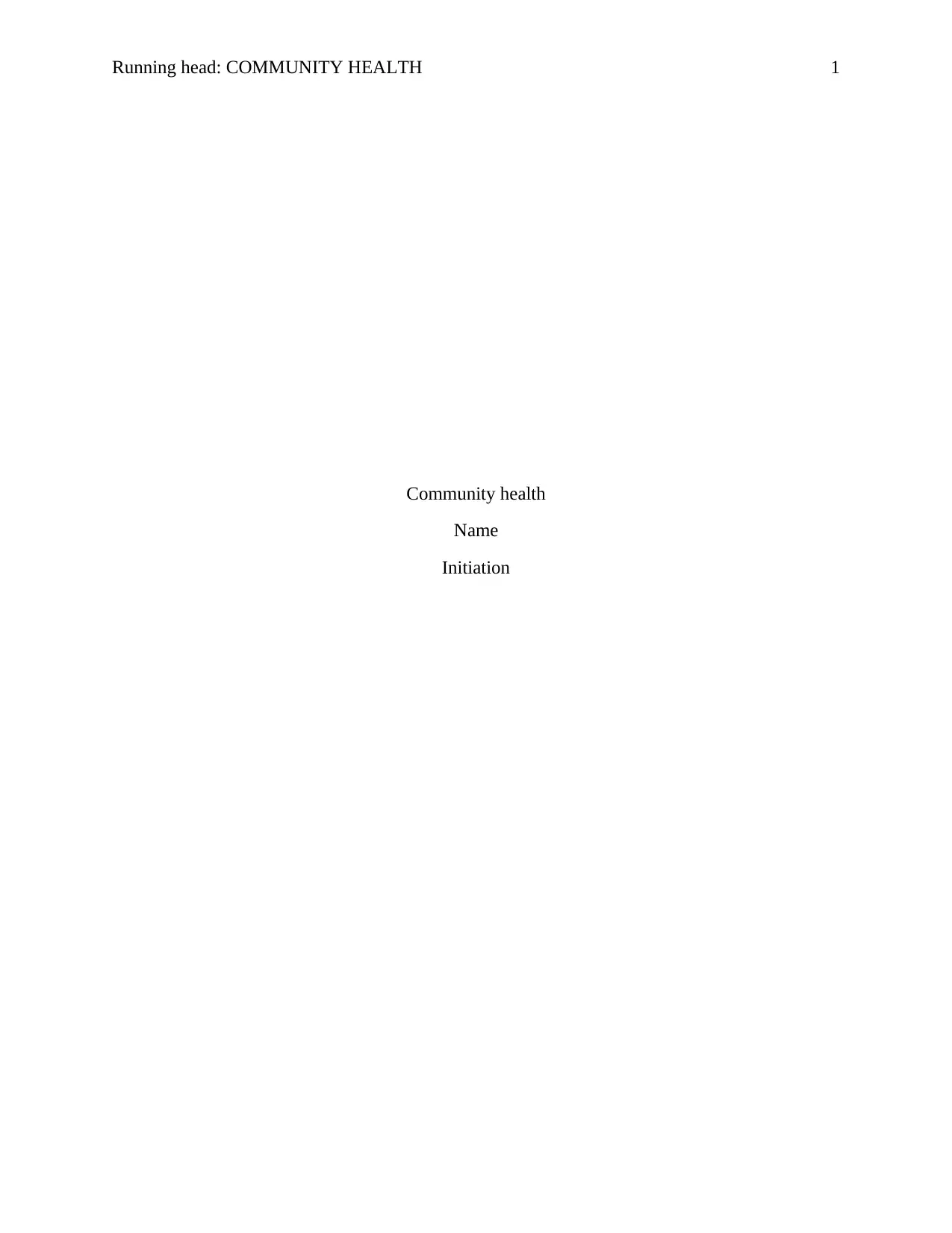
Running head: COMMUNITY HEALTH 1
Community health
Name
Initiation
Community health
Name
Initiation
Secure Best Marks with AI Grader
Need help grading? Try our AI Grader for instant feedback on your assignments.
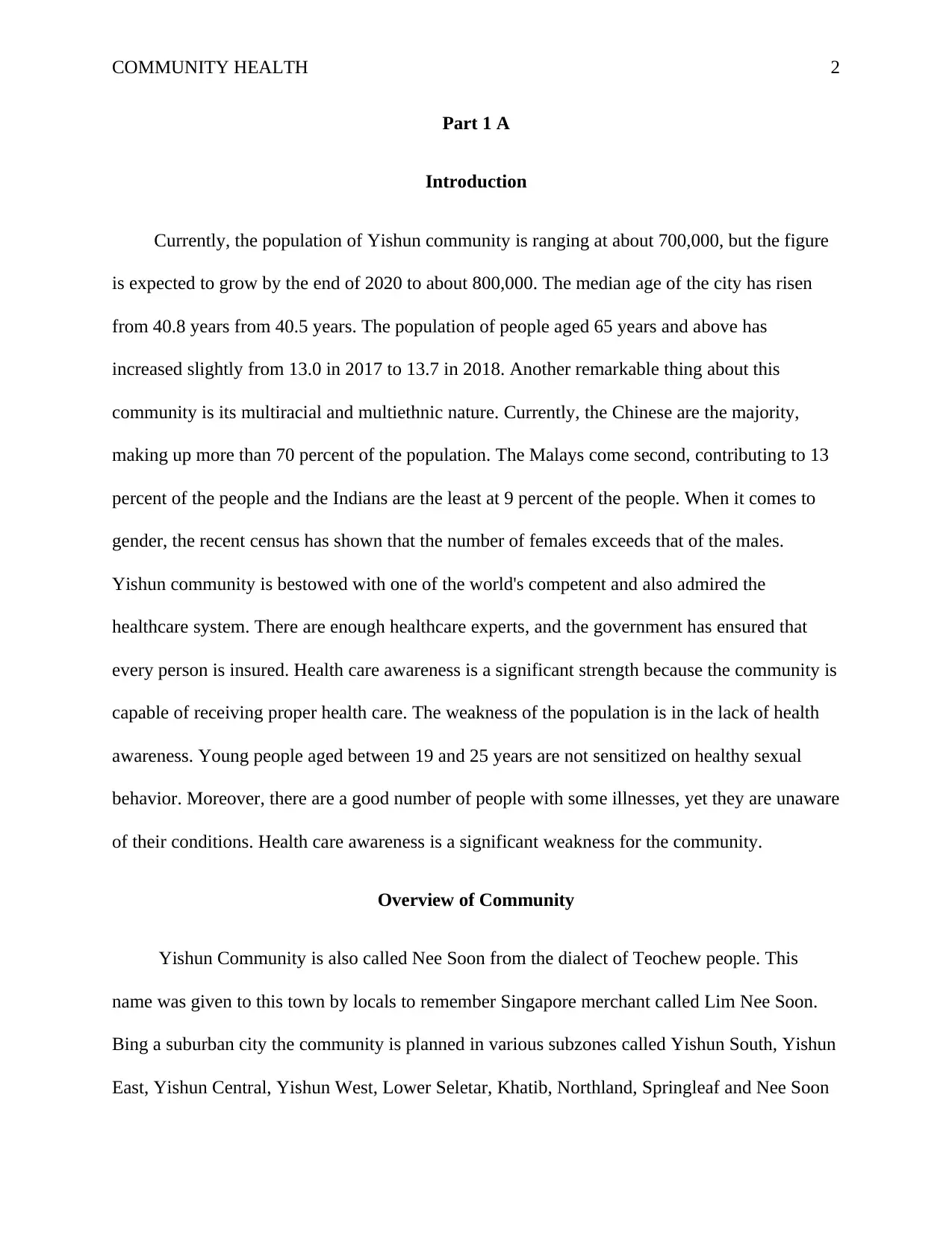
COMMUNITY HEALTH 2
Part 1 A
Introduction
Currently, the population of Yishun community is ranging at about 700,000, but the figure
is expected to grow by the end of 2020 to about 800,000. The median age of the city has risen
from 40.8 years from 40.5 years. The population of people aged 65 years and above has
increased slightly from 13.0 in 2017 to 13.7 in 2018. Another remarkable thing about this
community is its multiracial and multiethnic nature. Currently, the Chinese are the majority,
making up more than 70 percent of the population. The Malays come second, contributing to 13
percent of the people and the Indians are the least at 9 percent of the people. When it comes to
gender, the recent census has shown that the number of females exceeds that of the males.
Yishun community is bestowed with one of the world's competent and also admired the
healthcare system. There are enough healthcare experts, and the government has ensured that
every person is insured. Health care awareness is a significant strength because the community is
capable of receiving proper health care. The weakness of the population is in the lack of health
awareness. Young people aged between 19 and 25 years are not sensitized on healthy sexual
behavior. Moreover, there are a good number of people with some illnesses, yet they are unaware
of their conditions. Health care awareness is a significant weakness for the community.
Overview of Community
Yishun Community is also called Nee Soon from the dialect of Teochew people. This
name was given to this town by locals to remember Singapore merchant called Lim Nee Soon.
Bing a suburban city the community is planned in various subzones called Yishun South, Yishun
East, Yishun Central, Yishun West, Lower Seletar, Khatib, Northland, Springleaf and Nee Soon
Part 1 A
Introduction
Currently, the population of Yishun community is ranging at about 700,000, but the figure
is expected to grow by the end of 2020 to about 800,000. The median age of the city has risen
from 40.8 years from 40.5 years. The population of people aged 65 years and above has
increased slightly from 13.0 in 2017 to 13.7 in 2018. Another remarkable thing about this
community is its multiracial and multiethnic nature. Currently, the Chinese are the majority,
making up more than 70 percent of the population. The Malays come second, contributing to 13
percent of the people and the Indians are the least at 9 percent of the people. When it comes to
gender, the recent census has shown that the number of females exceeds that of the males.
Yishun community is bestowed with one of the world's competent and also admired the
healthcare system. There are enough healthcare experts, and the government has ensured that
every person is insured. Health care awareness is a significant strength because the community is
capable of receiving proper health care. The weakness of the population is in the lack of health
awareness. Young people aged between 19 and 25 years are not sensitized on healthy sexual
behavior. Moreover, there are a good number of people with some illnesses, yet they are unaware
of their conditions. Health care awareness is a significant weakness for the community.
Overview of Community
Yishun Community is also called Nee Soon from the dialect of Teochew people. This
name was given to this town by locals to remember Singapore merchant called Lim Nee Soon.
Bing a suburban city the community is planned in various subzones called Yishun South, Yishun
East, Yishun Central, Yishun West, Lower Seletar, Khatib, Northland, Springleaf and Nee Soon
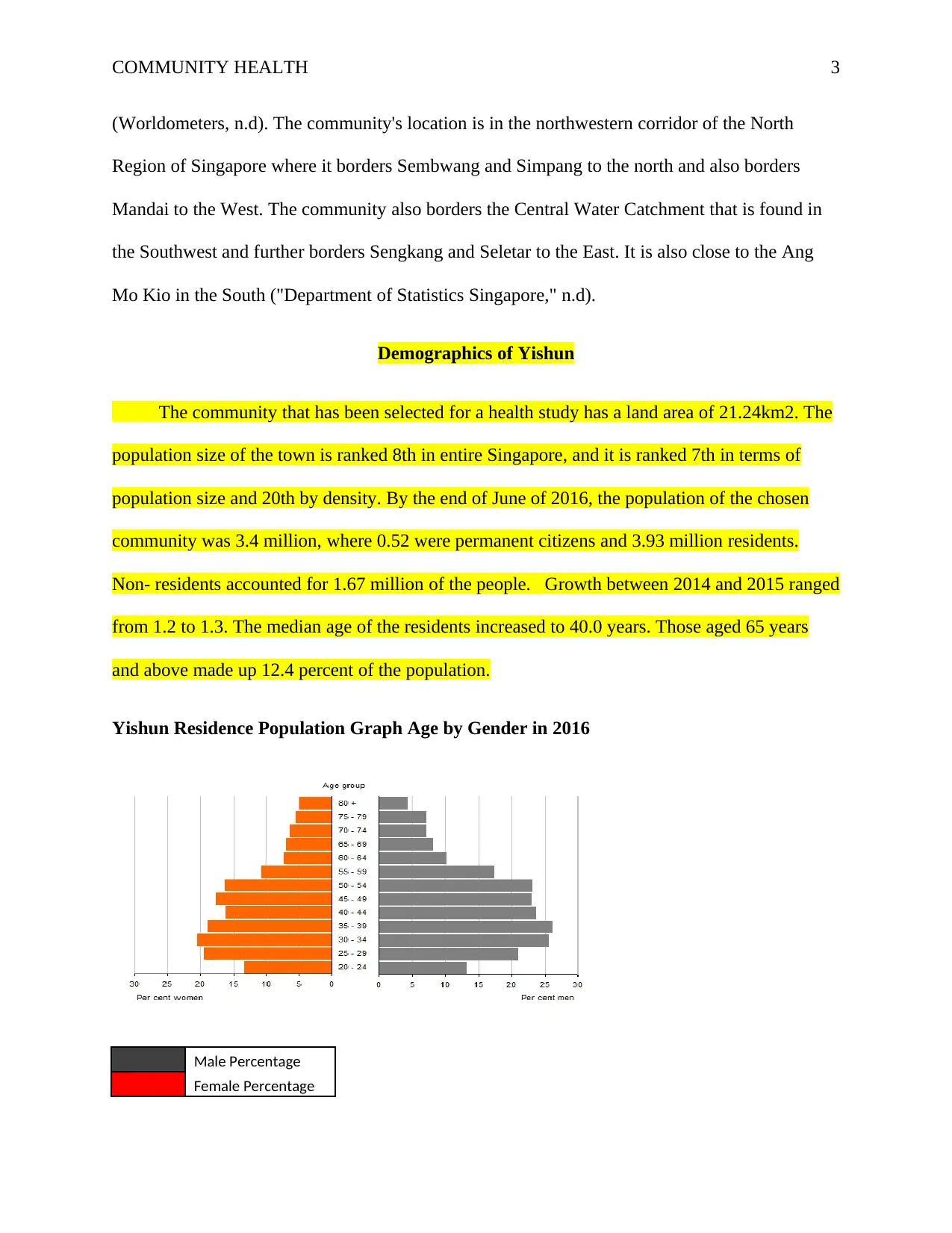
COMMUNITY HEALTH 3
(Worldometers, n.d). The community's location is in the northwestern corridor of the North
Region of Singapore where it borders Sembwang and Simpang to the north and also borders
Mandai to the West. The community also borders the Central Water Catchment that is found in
the Southwest and further borders Sengkang and Seletar to the East. It is also close to the Ang
Mo Kio in the South ("Department of Statistics Singapore," n.d).
Demographics of Yishun
The community that has been selected for a health study has a land area of 21.24km2. The
population size of the town is ranked 8th in entire Singapore, and it is ranked 7th in terms of
population size and 20th by density. By the end of June of 2016, the population of the chosen
community was 3.4 million, where 0.52 were permanent citizens and 3.93 million residents.
Non- residents accounted for 1.67 million of the people. Growth between 2014 and 2015 ranged
from 1.2 to 1.3. The median age of the residents increased to 40.0 years. Those aged 65 years
and above made up 12.4 percent of the population.
Yishun Residence Population Graph Age by Gender in 2016
Male Percentage
Female Percentage
(Worldometers, n.d). The community's location is in the northwestern corridor of the North
Region of Singapore where it borders Sembwang and Simpang to the north and also borders
Mandai to the West. The community also borders the Central Water Catchment that is found in
the Southwest and further borders Sengkang and Seletar to the East. It is also close to the Ang
Mo Kio in the South ("Department of Statistics Singapore," n.d).
Demographics of Yishun
The community that has been selected for a health study has a land area of 21.24km2. The
population size of the town is ranked 8th in entire Singapore, and it is ranked 7th in terms of
population size and 20th by density. By the end of June of 2016, the population of the chosen
community was 3.4 million, where 0.52 were permanent citizens and 3.93 million residents.
Non- residents accounted for 1.67 million of the people. Growth between 2014 and 2015 ranged
from 1.2 to 1.3. The median age of the residents increased to 40.0 years. Those aged 65 years
and above made up 12.4 percent of the population.
Yishun Residence Population Graph Age by Gender in 2016
Male Percentage
Female Percentage
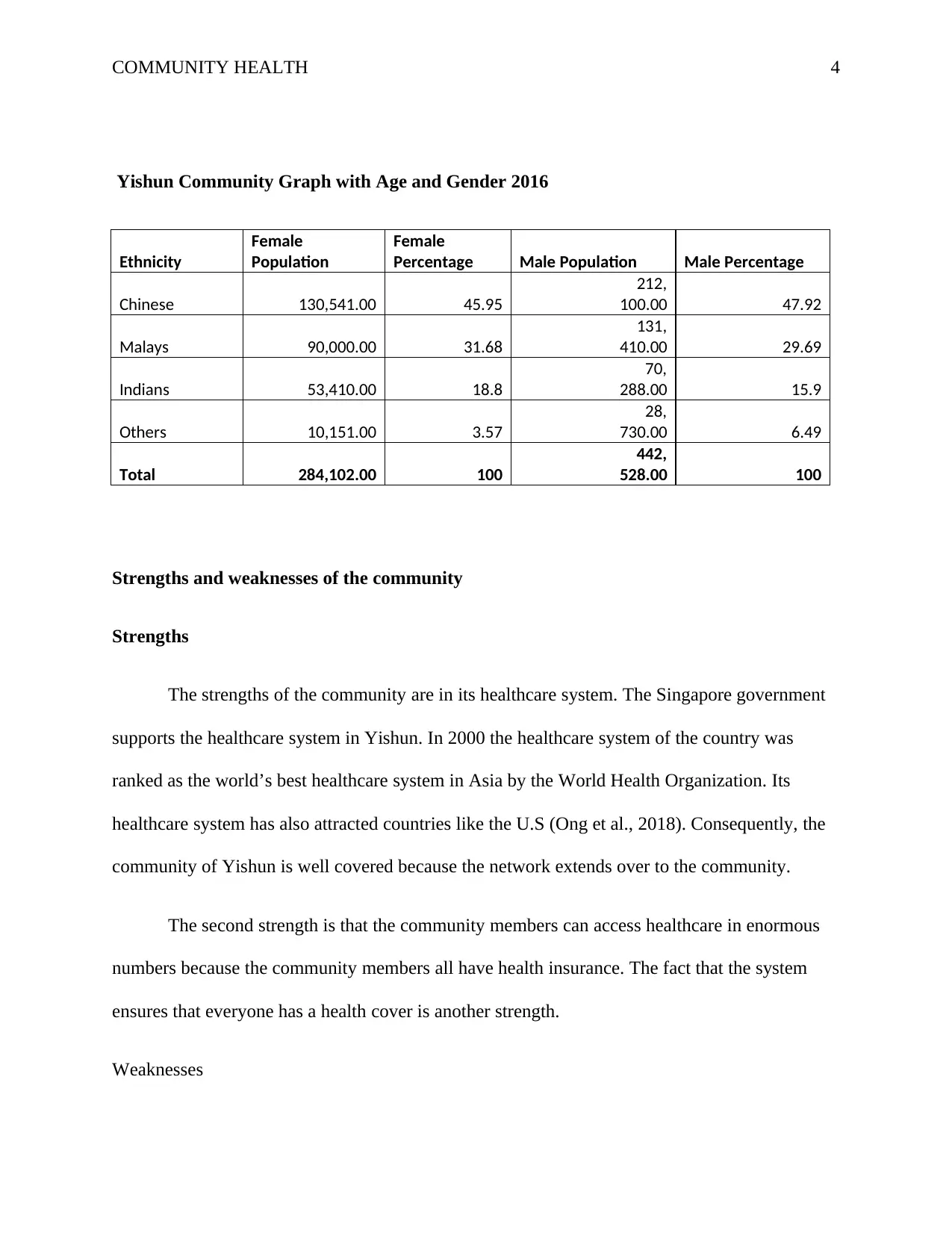
COMMUNITY HEALTH 4
Yishun Community Graph with Age and Gender 2016
Ethnicity
Female
Population
Female
Percentage Male Population Male Percentage
Chinese 130,541.00 45.95
212,
100.00 47.92
Malays 90,000.00 31.68
131,
410.00 29.69
Indians 53,410.00 18.8
70,
288.00 15.9
Others 10,151.00 3.57
28,
730.00 6.49
Total 284,102.00 100
442,
528.00 100
Strengths and weaknesses of the community
Strengths
The strengths of the community are in its healthcare system. The Singapore government
supports the healthcare system in Yishun. In 2000 the healthcare system of the country was
ranked as the world’s best healthcare system in Asia by the World Health Organization. Its
healthcare system has also attracted countries like the U.S (Ong et al., 2018). Consequently, the
community of Yishun is well covered because the network extends over to the community.
The second strength is that the community members can access healthcare in enormous
numbers because the community members all have health insurance. The fact that the system
ensures that everyone has a health cover is another strength.
Weaknesses
Yishun Community Graph with Age and Gender 2016
Ethnicity
Female
Population
Female
Percentage Male Population Male Percentage
Chinese 130,541.00 45.95
212,
100.00 47.92
Malays 90,000.00 31.68
131,
410.00 29.69
Indians 53,410.00 18.8
70,
288.00 15.9
Others 10,151.00 3.57
28,
730.00 6.49
Total 284,102.00 100
442,
528.00 100
Strengths and weaknesses of the community
Strengths
The strengths of the community are in its healthcare system. The Singapore government
supports the healthcare system in Yishun. In 2000 the healthcare system of the country was
ranked as the world’s best healthcare system in Asia by the World Health Organization. Its
healthcare system has also attracted countries like the U.S (Ong et al., 2018). Consequently, the
community of Yishun is well covered because the network extends over to the community.
The second strength is that the community members can access healthcare in enormous
numbers because the community members all have health insurance. The fact that the system
ensures that everyone has a health cover is another strength.
Weaknesses
Secure Best Marks with AI Grader
Need help grading? Try our AI Grader for instant feedback on your assignments.
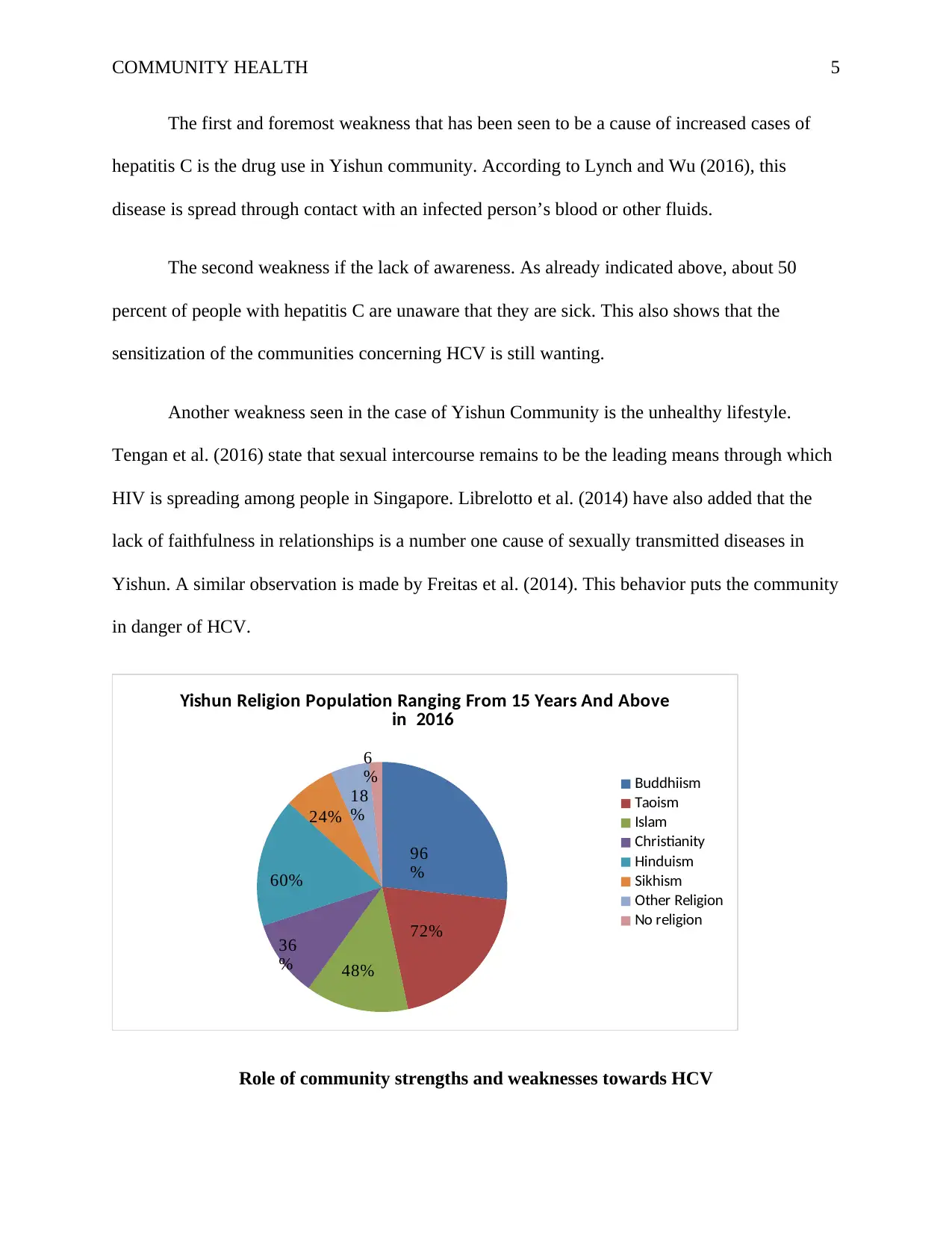
COMMUNITY HEALTH 5
The first and foremost weakness that has been seen to be a cause of increased cases of
hepatitis C is the drug use in Yishun community. According to Lynch and Wu (2016), this
disease is spread through contact with an infected person’s blood or other fluids.
The second weakness if the lack of awareness. As already indicated above, about 50
percent of people with hepatitis C are unaware that they are sick. This also shows that the
sensitization of the communities concerning HCV is still wanting.
Another weakness seen in the case of Yishun Community is the unhealthy lifestyle.
Tengan et al. (2016) state that sexual intercourse remains to be the leading means through which
HIV is spreading among people in Singapore. Librelotto et al. (2014) have also added that the
lack of faithfulness in relationships is a number one cause of sexually transmitted diseases in
Yishun. A similar observation is made by Freitas et al. (2014). This behavior puts the community
in danger of HCV.
Yishun Religion Population Ranging From 15 Years And Above
in 2016
Buddhiism
Taoism
Islam
Christianity
Hinduism
Sikhism
Other Religion
No religion
96
%
72%
48%
36
%
60%
24%
18
%
6
%
Role of community strengths and weaknesses towards HCV
The first and foremost weakness that has been seen to be a cause of increased cases of
hepatitis C is the drug use in Yishun community. According to Lynch and Wu (2016), this
disease is spread through contact with an infected person’s blood or other fluids.
The second weakness if the lack of awareness. As already indicated above, about 50
percent of people with hepatitis C are unaware that they are sick. This also shows that the
sensitization of the communities concerning HCV is still wanting.
Another weakness seen in the case of Yishun Community is the unhealthy lifestyle.
Tengan et al. (2016) state that sexual intercourse remains to be the leading means through which
HIV is spreading among people in Singapore. Librelotto et al. (2014) have also added that the
lack of faithfulness in relationships is a number one cause of sexually transmitted diseases in
Yishun. A similar observation is made by Freitas et al. (2014). This behavior puts the community
in danger of HCV.
Yishun Religion Population Ranging From 15 Years And Above
in 2016
Buddhiism
Taoism
Islam
Christianity
Hinduism
Sikhism
Other Religion
No religion
96
%
72%
48%
36
%
60%
24%
18
%
6
%
Role of community strengths and weaknesses towards HCV
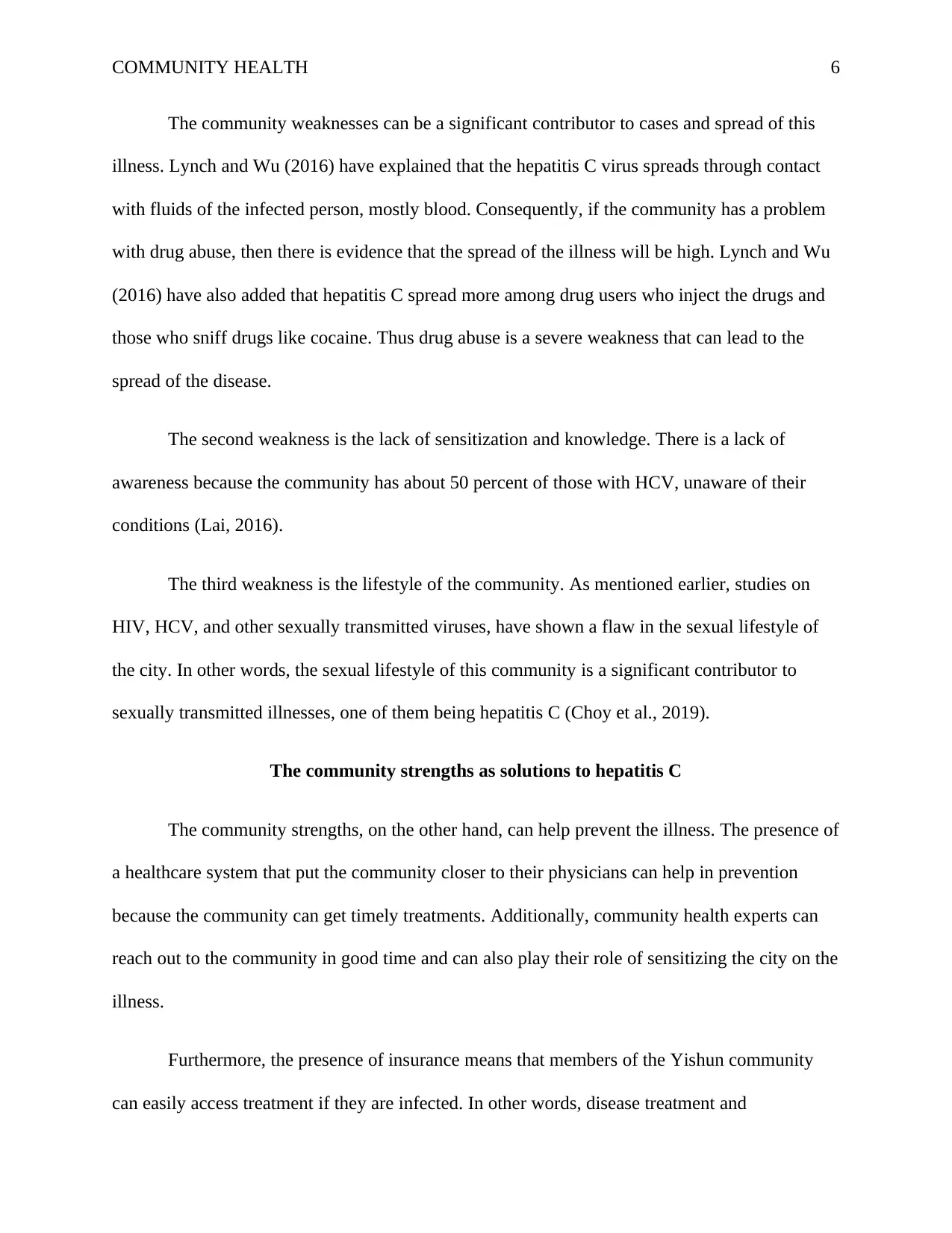
COMMUNITY HEALTH 6
The community weaknesses can be a significant contributor to cases and spread of this
illness. Lynch and Wu (2016) have explained that the hepatitis C virus spreads through contact
with fluids of the infected person, mostly blood. Consequently, if the community has a problem
with drug abuse, then there is evidence that the spread of the illness will be high. Lynch and Wu
(2016) have also added that hepatitis C spread more among drug users who inject the drugs and
those who sniff drugs like cocaine. Thus drug abuse is a severe weakness that can lead to the
spread of the disease.
The second weakness is the lack of sensitization and knowledge. There is a lack of
awareness because the community has about 50 percent of those with HCV, unaware of their
conditions (Lai, 2016).
The third weakness is the lifestyle of the community. As mentioned earlier, studies on
HIV, HCV, and other sexually transmitted viruses, have shown a flaw in the sexual lifestyle of
the city. In other words, the sexual lifestyle of this community is a significant contributor to
sexually transmitted illnesses, one of them being hepatitis C (Choy et al., 2019).
The community strengths as solutions to hepatitis C
The community strengths, on the other hand, can help prevent the illness. The presence of
a healthcare system that put the community closer to their physicians can help in prevention
because the community can get timely treatments. Additionally, community health experts can
reach out to the community in good time and can also play their role of sensitizing the city on the
illness.
Furthermore, the presence of insurance means that members of the Yishun community
can easily access treatment if they are infected. In other words, disease treatment and
The community weaknesses can be a significant contributor to cases and spread of this
illness. Lynch and Wu (2016) have explained that the hepatitis C virus spreads through contact
with fluids of the infected person, mostly blood. Consequently, if the community has a problem
with drug abuse, then there is evidence that the spread of the illness will be high. Lynch and Wu
(2016) have also added that hepatitis C spread more among drug users who inject the drugs and
those who sniff drugs like cocaine. Thus drug abuse is a severe weakness that can lead to the
spread of the disease.
The second weakness is the lack of sensitization and knowledge. There is a lack of
awareness because the community has about 50 percent of those with HCV, unaware of their
conditions (Lai, 2016).
The third weakness is the lifestyle of the community. As mentioned earlier, studies on
HIV, HCV, and other sexually transmitted viruses, have shown a flaw in the sexual lifestyle of
the city. In other words, the sexual lifestyle of this community is a significant contributor to
sexually transmitted illnesses, one of them being hepatitis C (Choy et al., 2019).
The community strengths as solutions to hepatitis C
The community strengths, on the other hand, can help prevent the illness. The presence of
a healthcare system that put the community closer to their physicians can help in prevention
because the community can get timely treatments. Additionally, community health experts can
reach out to the community in good time and can also play their role of sensitizing the city on the
illness.
Furthermore, the presence of insurance means that members of the Yishun community
can easily access treatment if they are infected. In other words, disease treatment and
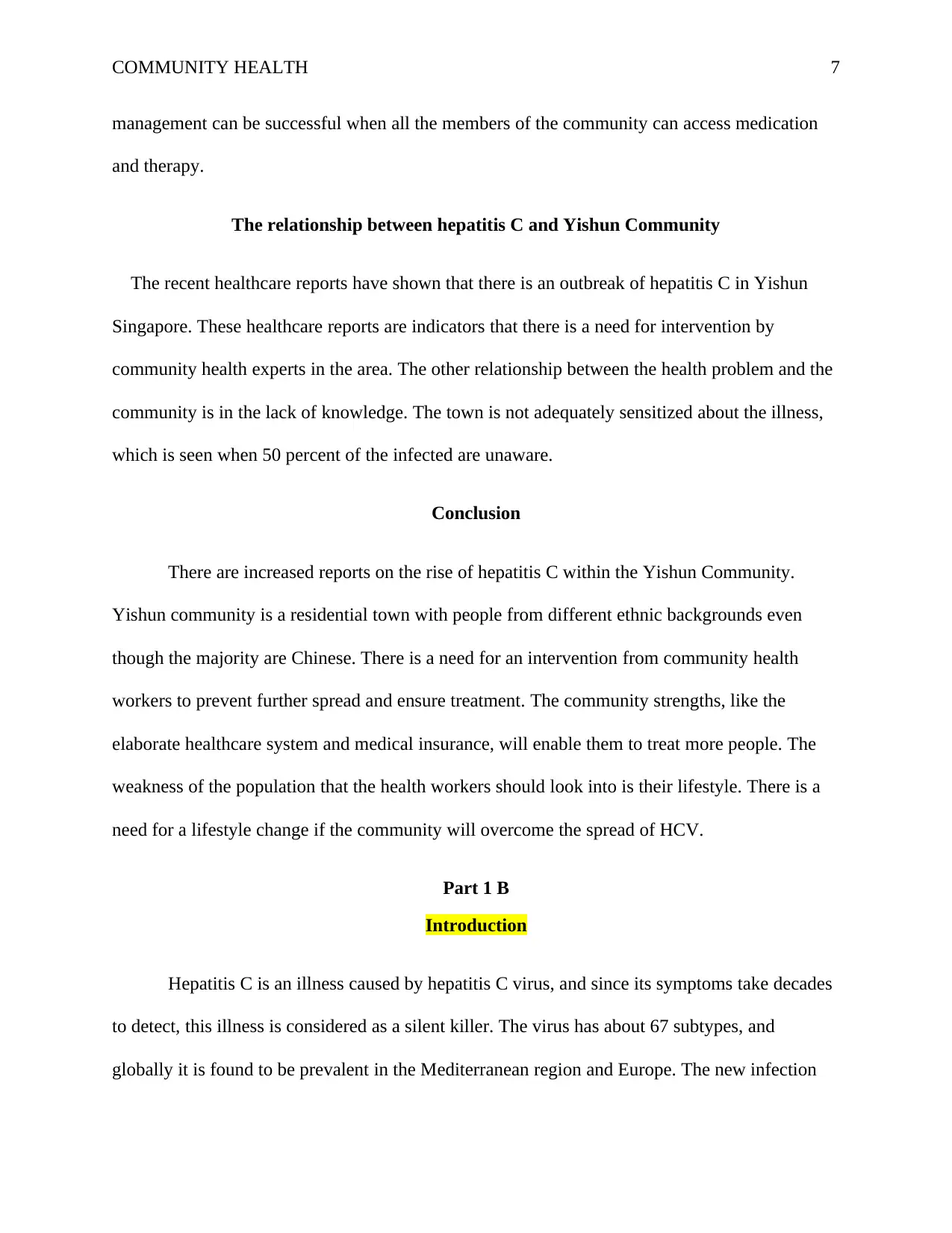
COMMUNITY HEALTH 7
management can be successful when all the members of the community can access medication
and therapy.
The relationship between hepatitis C and Yishun Community
The recent healthcare reports have shown that there is an outbreak of hepatitis C in Yishun
Singapore. These healthcare reports are indicators that there is a need for intervention by
community health experts in the area. The other relationship between the health problem and the
community is in the lack of knowledge. The town is not adequately sensitized about the illness,
which is seen when 50 percent of the infected are unaware.
Conclusion
There are increased reports on the rise of hepatitis C within the Yishun Community.
Yishun community is a residential town with people from different ethnic backgrounds even
though the majority are Chinese. There is a need for an intervention from community health
workers to prevent further spread and ensure treatment. The community strengths, like the
elaborate healthcare system and medical insurance, will enable them to treat more people. The
weakness of the population that the health workers should look into is their lifestyle. There is a
need for a lifestyle change if the community will overcome the spread of HCV.
Part 1 B
Introduction
Hepatitis C is an illness caused by hepatitis C virus, and since its symptoms take decades
to detect, this illness is considered as a silent killer. The virus has about 67 subtypes, and
globally it is found to be prevalent in the Mediterranean region and Europe. The new infection
management can be successful when all the members of the community can access medication
and therapy.
The relationship between hepatitis C and Yishun Community
The recent healthcare reports have shown that there is an outbreak of hepatitis C in Yishun
Singapore. These healthcare reports are indicators that there is a need for intervention by
community health experts in the area. The other relationship between the health problem and the
community is in the lack of knowledge. The town is not adequately sensitized about the illness,
which is seen when 50 percent of the infected are unaware.
Conclusion
There are increased reports on the rise of hepatitis C within the Yishun Community.
Yishun community is a residential town with people from different ethnic backgrounds even
though the majority are Chinese. There is a need for an intervention from community health
workers to prevent further spread and ensure treatment. The community strengths, like the
elaborate healthcare system and medical insurance, will enable them to treat more people. The
weakness of the population that the health workers should look into is their lifestyle. There is a
need for a lifestyle change if the community will overcome the spread of HCV.
Part 1 B
Introduction
Hepatitis C is an illness caused by hepatitis C virus, and since its symptoms take decades
to detect, this illness is considered as a silent killer. The virus has about 67 subtypes, and
globally it is found to be prevalent in the Mediterranean region and Europe. The new infection
Paraphrase This Document
Need a fresh take? Get an instant paraphrase of this document with our AI Paraphraser
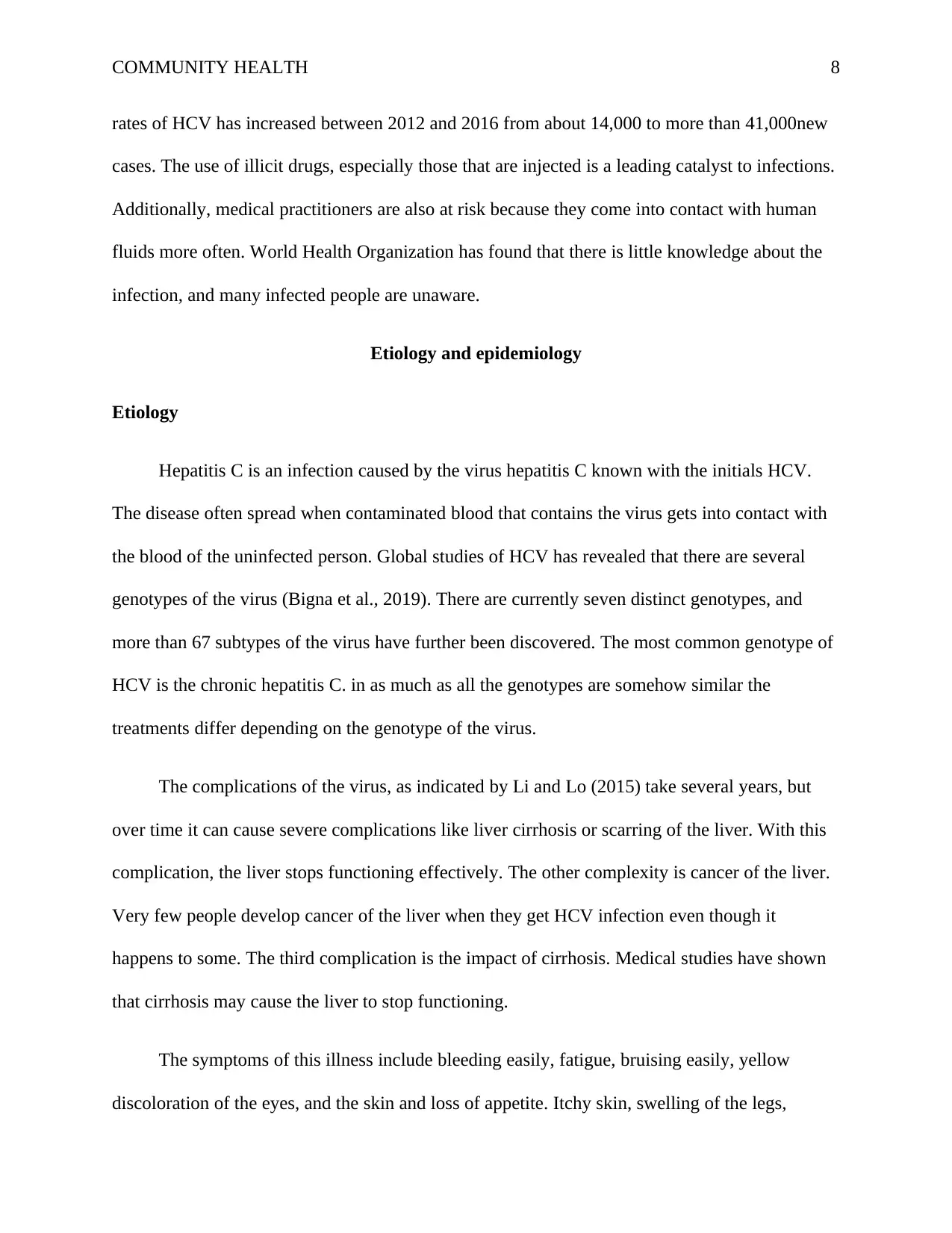
COMMUNITY HEALTH 8
rates of HCV has increased between 2012 and 2016 from about 14,000 to more than 41,000new
cases. The use of illicit drugs, especially those that are injected is a leading catalyst to infections.
Additionally, medical practitioners are also at risk because they come into contact with human
fluids more often. World Health Organization has found that there is little knowledge about the
infection, and many infected people are unaware.
Etiology and epidemiology
Etiology
Hepatitis C is an infection caused by the virus hepatitis C known with the initials HCV.
The disease often spread when contaminated blood that contains the virus gets into contact with
the blood of the uninfected person. Global studies of HCV has revealed that there are several
genotypes of the virus (Bigna et al., 2019). There are currently seven distinct genotypes, and
more than 67 subtypes of the virus have further been discovered. The most common genotype of
HCV is the chronic hepatitis C. in as much as all the genotypes are somehow similar the
treatments differ depending on the genotype of the virus.
The complications of the virus, as indicated by Li and Lo (2015) take several years, but
over time it can cause severe complications like liver cirrhosis or scarring of the liver. With this
complication, the liver stops functioning effectively. The other complexity is cancer of the liver.
Very few people develop cancer of the liver when they get HCV infection even though it
happens to some. The third complication is the impact of cirrhosis. Medical studies have shown
that cirrhosis may cause the liver to stop functioning.
The symptoms of this illness include bleeding easily, fatigue, bruising easily, yellow
discoloration of the eyes, and the skin and loss of appetite. Itchy skin, swelling of the legs,
rates of HCV has increased between 2012 and 2016 from about 14,000 to more than 41,000new
cases. The use of illicit drugs, especially those that are injected is a leading catalyst to infections.
Additionally, medical practitioners are also at risk because they come into contact with human
fluids more often. World Health Organization has found that there is little knowledge about the
infection, and many infected people are unaware.
Etiology and epidemiology
Etiology
Hepatitis C is an infection caused by the virus hepatitis C known with the initials HCV.
The disease often spread when contaminated blood that contains the virus gets into contact with
the blood of the uninfected person. Global studies of HCV has revealed that there are several
genotypes of the virus (Bigna et al., 2019). There are currently seven distinct genotypes, and
more than 67 subtypes of the virus have further been discovered. The most common genotype of
HCV is the chronic hepatitis C. in as much as all the genotypes are somehow similar the
treatments differ depending on the genotype of the virus.
The complications of the virus, as indicated by Li and Lo (2015) take several years, but
over time it can cause severe complications like liver cirrhosis or scarring of the liver. With this
complication, the liver stops functioning effectively. The other complexity is cancer of the liver.
Very few people develop cancer of the liver when they get HCV infection even though it
happens to some. The third complication is the impact of cirrhosis. Medical studies have shown
that cirrhosis may cause the liver to stop functioning.
The symptoms of this illness include bleeding easily, fatigue, bruising easily, yellow
discoloration of the eyes, and the skin and loss of appetite. Itchy skin, swelling of the legs,
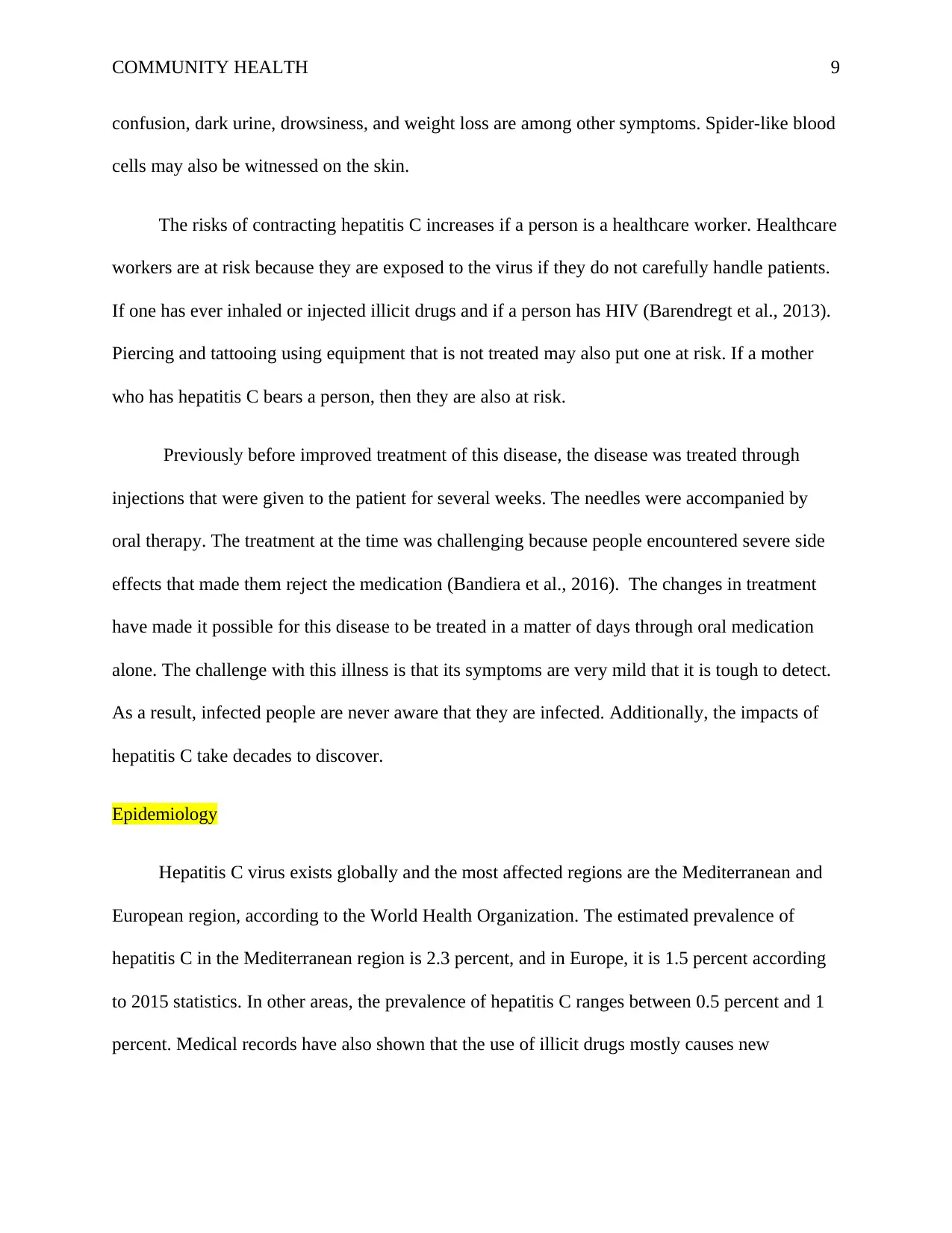
COMMUNITY HEALTH 9
confusion, dark urine, drowsiness, and weight loss are among other symptoms. Spider-like blood
cells may also be witnessed on the skin.
The risks of contracting hepatitis C increases if a person is a healthcare worker. Healthcare
workers are at risk because they are exposed to the virus if they do not carefully handle patients.
If one has ever inhaled or injected illicit drugs and if a person has HIV (Barendregt et al., 2013).
Piercing and tattooing using equipment that is not treated may also put one at risk. If a mother
who has hepatitis C bears a person, then they are also at risk.
Previously before improved treatment of this disease, the disease was treated through
injections that were given to the patient for several weeks. The needles were accompanied by
oral therapy. The treatment at the time was challenging because people encountered severe side
effects that made them reject the medication (Bandiera et al., 2016). The changes in treatment
have made it possible for this disease to be treated in a matter of days through oral medication
alone. The challenge with this illness is that its symptoms are very mild that it is tough to detect.
As a result, infected people are never aware that they are infected. Additionally, the impacts of
hepatitis C take decades to discover.
Epidemiology
Hepatitis C virus exists globally and the most affected regions are the Mediterranean and
European region, according to the World Health Organization. The estimated prevalence of
hepatitis C in the Mediterranean region is 2.3 percent, and in Europe, it is 1.5 percent according
to 2015 statistics. In other areas, the prevalence of hepatitis C ranges between 0.5 percent and 1
percent. Medical records have also shown that the use of illicit drugs mostly causes new
confusion, dark urine, drowsiness, and weight loss are among other symptoms. Spider-like blood
cells may also be witnessed on the skin.
The risks of contracting hepatitis C increases if a person is a healthcare worker. Healthcare
workers are at risk because they are exposed to the virus if they do not carefully handle patients.
If one has ever inhaled or injected illicit drugs and if a person has HIV (Barendregt et al., 2013).
Piercing and tattooing using equipment that is not treated may also put one at risk. If a mother
who has hepatitis C bears a person, then they are also at risk.
Previously before improved treatment of this disease, the disease was treated through
injections that were given to the patient for several weeks. The needles were accompanied by
oral therapy. The treatment at the time was challenging because people encountered severe side
effects that made them reject the medication (Bandiera et al., 2016). The changes in treatment
have made it possible for this disease to be treated in a matter of days through oral medication
alone. The challenge with this illness is that its symptoms are very mild that it is tough to detect.
As a result, infected people are never aware that they are infected. Additionally, the impacts of
hepatitis C take decades to discover.
Epidemiology
Hepatitis C virus exists globally and the most affected regions are the Mediterranean and
European region, according to the World Health Organization. The estimated prevalence of
hepatitis C in the Mediterranean region is 2.3 percent, and in Europe, it is 1.5 percent according
to 2015 statistics. In other areas, the prevalence of hepatitis C ranges between 0.5 percent and 1
percent. Medical records have also shown that the use of illicit drugs mostly causes new
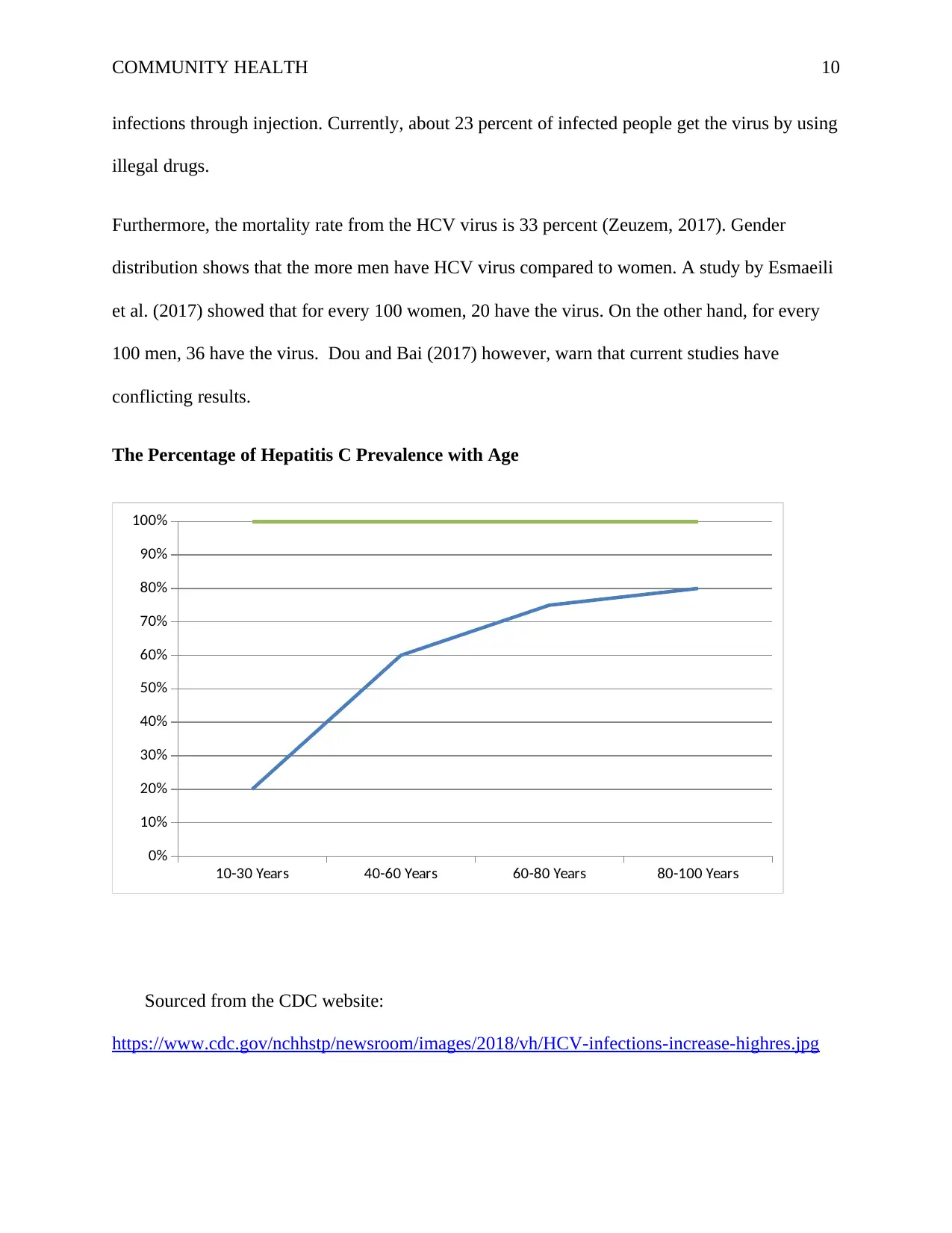
COMMUNITY HEALTH 10
infections through injection. Currently, about 23 percent of infected people get the virus by using
illegal drugs.
Furthermore, the mortality rate from the HCV virus is 33 percent (Zeuzem, 2017). Gender
distribution shows that the more men have HCV virus compared to women. A study by Esmaeili
et al. (2017) showed that for every 100 women, 20 have the virus. On the other hand, for every
100 men, 36 have the virus. Dou and Bai (2017) however, warn that current studies have
conflicting results.
The Percentage of Hepatitis C Prevalence with Age
10-30 Years 40-60 Years 60-80 Years 80-100 Years
0%
10%
20%
30%
40%
50%
60%
70%
80%
90%
100%
Sourced from the CDC website:
https://www.cdc.gov/nchhstp/newsroom/images/2018/vh/HCV-infections-increase-highres.jpg
infections through injection. Currently, about 23 percent of infected people get the virus by using
illegal drugs.
Furthermore, the mortality rate from the HCV virus is 33 percent (Zeuzem, 2017). Gender
distribution shows that the more men have HCV virus compared to women. A study by Esmaeili
et al. (2017) showed that for every 100 women, 20 have the virus. On the other hand, for every
100 men, 36 have the virus. Dou and Bai (2017) however, warn that current studies have
conflicting results.
The Percentage of Hepatitis C Prevalence with Age
10-30 Years 40-60 Years 60-80 Years 80-100 Years
0%
10%
20%
30%
40%
50%
60%
70%
80%
90%
100%
Sourced from the CDC website:
https://www.cdc.gov/nchhstp/newsroom/images/2018/vh/HCV-infections-increase-highres.jpg
Secure Best Marks with AI Grader
Need help grading? Try our AI Grader for instant feedback on your assignments.
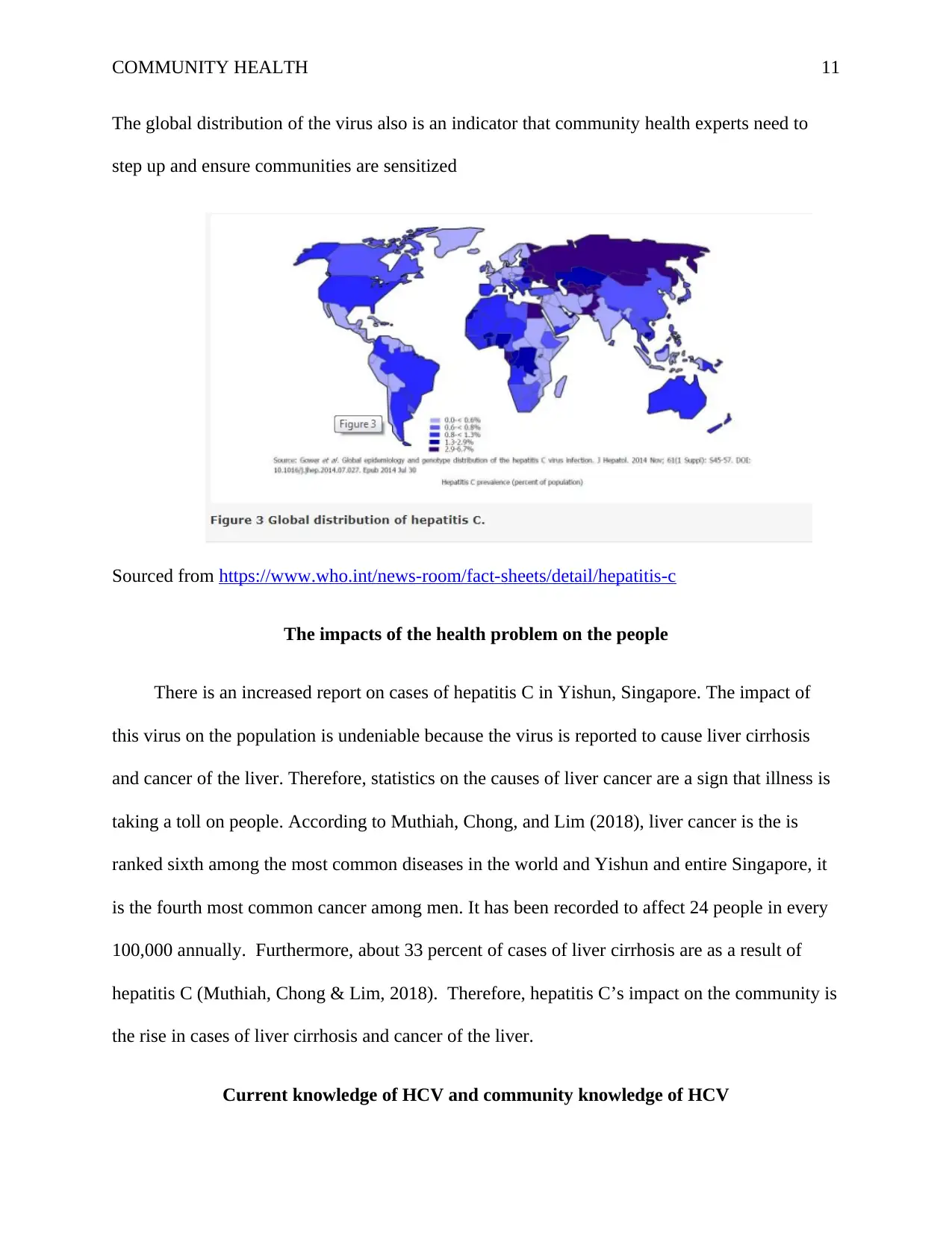
COMMUNITY HEALTH 11
The global distribution of the virus also is an indicator that community health experts need to
step up and ensure communities are sensitized
Sourced from https://www.who.int/news-room/fact-sheets/detail/hepatitis-c
The impacts of the health problem on the people
There is an increased report on cases of hepatitis C in Yishun, Singapore. The impact of
this virus on the population is undeniable because the virus is reported to cause liver cirrhosis
and cancer of the liver. Therefore, statistics on the causes of liver cancer are a sign that illness is
taking a toll on people. According to Muthiah, Chong, and Lim (2018), liver cancer is the is
ranked sixth among the most common diseases in the world and Yishun and entire Singapore, it
is the fourth most common cancer among men. It has been recorded to affect 24 people in every
100,000 annually. Furthermore, about 33 percent of cases of liver cirrhosis are as a result of
hepatitis C (Muthiah, Chong & Lim, 2018). Therefore, hepatitis C’s impact on the community is
the rise in cases of liver cirrhosis and cancer of the liver.
Current knowledge of HCV and community knowledge of HCV
The global distribution of the virus also is an indicator that community health experts need to
step up and ensure communities are sensitized
Sourced from https://www.who.int/news-room/fact-sheets/detail/hepatitis-c
The impacts of the health problem on the people
There is an increased report on cases of hepatitis C in Yishun, Singapore. The impact of
this virus on the population is undeniable because the virus is reported to cause liver cirrhosis
and cancer of the liver. Therefore, statistics on the causes of liver cancer are a sign that illness is
taking a toll on people. According to Muthiah, Chong, and Lim (2018), liver cancer is the is
ranked sixth among the most common diseases in the world and Yishun and entire Singapore, it
is the fourth most common cancer among men. It has been recorded to affect 24 people in every
100,000 annually. Furthermore, about 33 percent of cases of liver cirrhosis are as a result of
hepatitis C (Muthiah, Chong & Lim, 2018). Therefore, hepatitis C’s impact on the community is
the rise in cases of liver cirrhosis and cancer of the liver.
Current knowledge of HCV and community knowledge of HCV
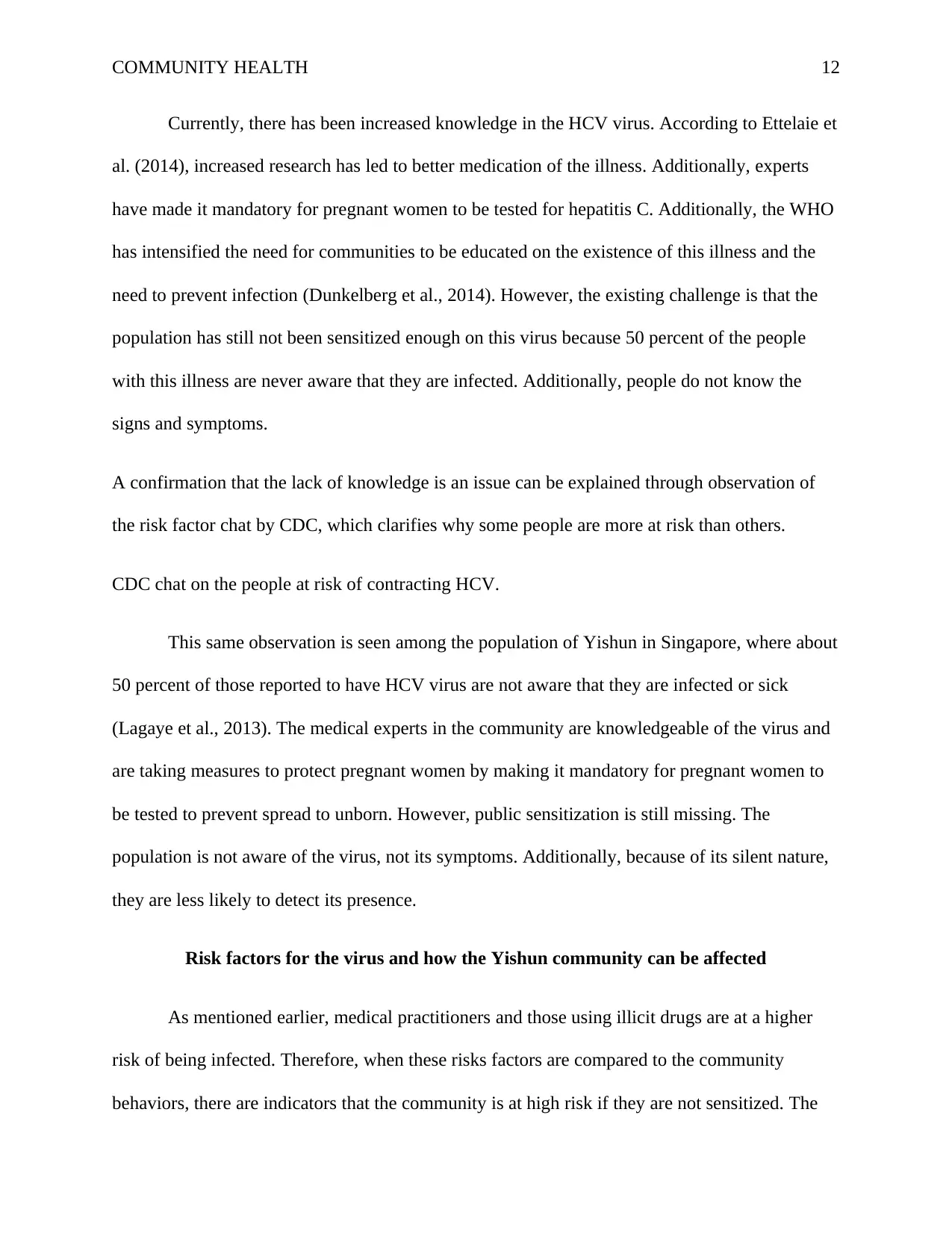
COMMUNITY HEALTH 12
Currently, there has been increased knowledge in the HCV virus. According to Ettelaie et
al. (2014), increased research has led to better medication of the illness. Additionally, experts
have made it mandatory for pregnant women to be tested for hepatitis C. Additionally, the WHO
has intensified the need for communities to be educated on the existence of this illness and the
need to prevent infection (Dunkelberg et al., 2014). However, the existing challenge is that the
population has still not been sensitized enough on this virus because 50 percent of the people
with this illness are never aware that they are infected. Additionally, people do not know the
signs and symptoms.
A confirmation that the lack of knowledge is an issue can be explained through observation of
the risk factor chat by CDC, which clarifies why some people are more at risk than others.
CDC chat on the people at risk of contracting HCV.
This same observation is seen among the population of Yishun in Singapore, where about
50 percent of those reported to have HCV virus are not aware that they are infected or sick
(Lagaye et al., 2013). The medical experts in the community are knowledgeable of the virus and
are taking measures to protect pregnant women by making it mandatory for pregnant women to
be tested to prevent spread to unborn. However, public sensitization is still missing. The
population is not aware of the virus, not its symptoms. Additionally, because of its silent nature,
they are less likely to detect its presence.
Risk factors for the virus and how the Yishun community can be affected
As mentioned earlier, medical practitioners and those using illicit drugs are at a higher
risk of being infected. Therefore, when these risks factors are compared to the community
behaviors, there are indicators that the community is at high risk if they are not sensitized. The
Currently, there has been increased knowledge in the HCV virus. According to Ettelaie et
al. (2014), increased research has led to better medication of the illness. Additionally, experts
have made it mandatory for pregnant women to be tested for hepatitis C. Additionally, the WHO
has intensified the need for communities to be educated on the existence of this illness and the
need to prevent infection (Dunkelberg et al., 2014). However, the existing challenge is that the
population has still not been sensitized enough on this virus because 50 percent of the people
with this illness are never aware that they are infected. Additionally, people do not know the
signs and symptoms.
A confirmation that the lack of knowledge is an issue can be explained through observation of
the risk factor chat by CDC, which clarifies why some people are more at risk than others.
CDC chat on the people at risk of contracting HCV.
This same observation is seen among the population of Yishun in Singapore, where about
50 percent of those reported to have HCV virus are not aware that they are infected or sick
(Lagaye et al., 2013). The medical experts in the community are knowledgeable of the virus and
are taking measures to protect pregnant women by making it mandatory for pregnant women to
be tested to prevent spread to unborn. However, public sensitization is still missing. The
population is not aware of the virus, not its symptoms. Additionally, because of its silent nature,
they are less likely to detect its presence.
Risk factors for the virus and how the Yishun community can be affected
As mentioned earlier, medical practitioners and those using illicit drugs are at a higher
risk of being infected. Therefore, when these risks factors are compared to the community
behaviors, there are indicators that the community is at high risk if they are not sensitized. The
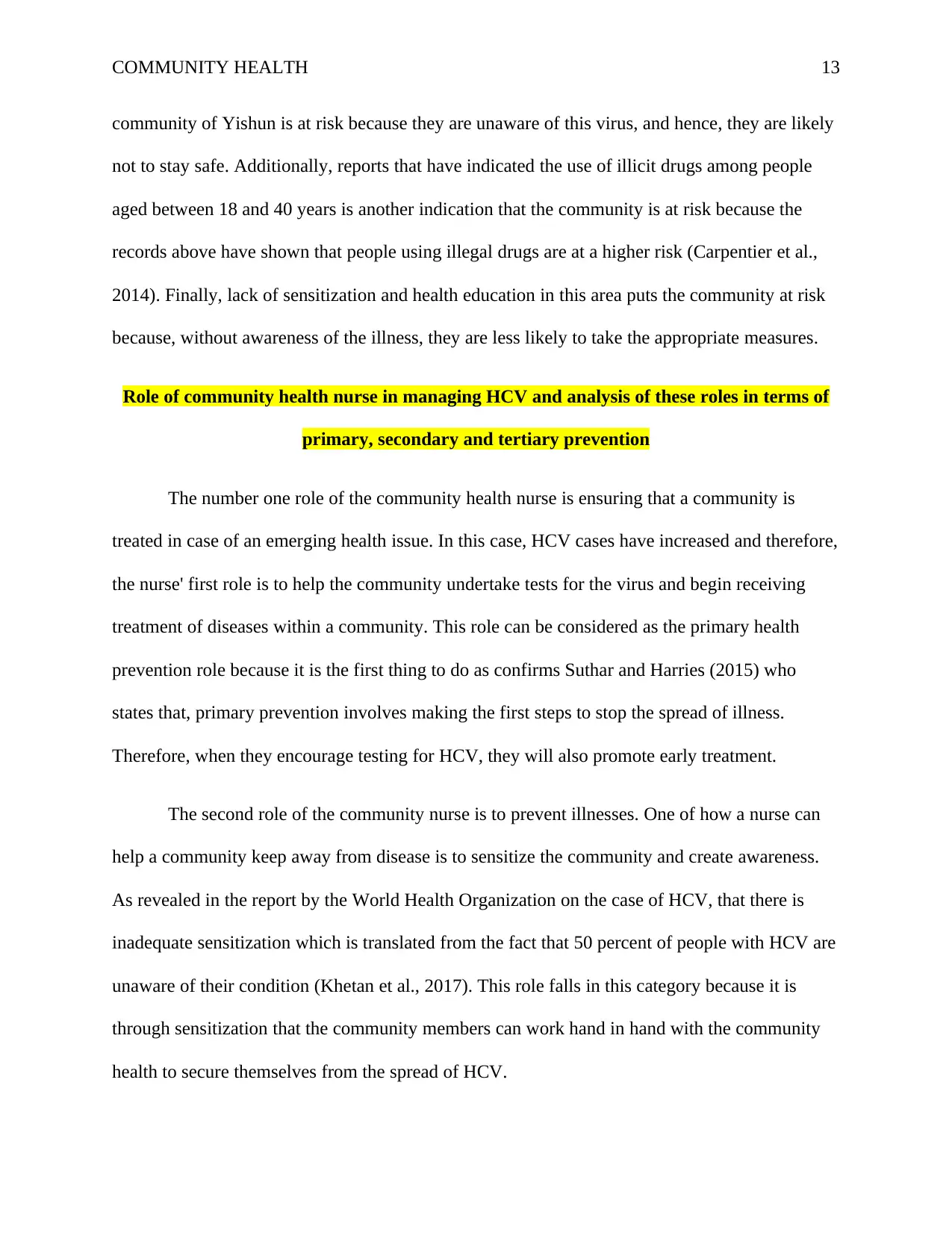
COMMUNITY HEALTH 13
community of Yishun is at risk because they are unaware of this virus, and hence, they are likely
not to stay safe. Additionally, reports that have indicated the use of illicit drugs among people
aged between 18 and 40 years is another indication that the community is at risk because the
records above have shown that people using illegal drugs are at a higher risk (Carpentier et al.,
2014). Finally, lack of sensitization and health education in this area puts the community at risk
because, without awareness of the illness, they are less likely to take the appropriate measures.
Role of community health nurse in managing HCV and analysis of these roles in terms of
primary, secondary and tertiary prevention
The number one role of the community health nurse is ensuring that a community is
treated in case of an emerging health issue. In this case, HCV cases have increased and therefore,
the nurse' first role is to help the community undertake tests for the virus and begin receiving
treatment of diseases within a community. This role can be considered as the primary health
prevention role because it is the first thing to do as confirms Suthar and Harries (2015) who
states that, primary prevention involves making the first steps to stop the spread of illness.
Therefore, when they encourage testing for HCV, they will also promote early treatment.
The second role of the community nurse is to prevent illnesses. One of how a nurse can
help a community keep away from disease is to sensitize the community and create awareness.
As revealed in the report by the World Health Organization on the case of HCV, that there is
inadequate sensitization which is translated from the fact that 50 percent of people with HCV are
unaware of their condition (Khetan et al., 2017). This role falls in this category because it is
through sensitization that the community members can work hand in hand with the community
health to secure themselves from the spread of HCV.
community of Yishun is at risk because they are unaware of this virus, and hence, they are likely
not to stay safe. Additionally, reports that have indicated the use of illicit drugs among people
aged between 18 and 40 years is another indication that the community is at risk because the
records above have shown that people using illegal drugs are at a higher risk (Carpentier et al.,
2014). Finally, lack of sensitization and health education in this area puts the community at risk
because, without awareness of the illness, they are less likely to take the appropriate measures.
Role of community health nurse in managing HCV and analysis of these roles in terms of
primary, secondary and tertiary prevention
The number one role of the community health nurse is ensuring that a community is
treated in case of an emerging health issue. In this case, HCV cases have increased and therefore,
the nurse' first role is to help the community undertake tests for the virus and begin receiving
treatment of diseases within a community. This role can be considered as the primary health
prevention role because it is the first thing to do as confirms Suthar and Harries (2015) who
states that, primary prevention involves making the first steps to stop the spread of illness.
Therefore, when they encourage testing for HCV, they will also promote early treatment.
The second role of the community nurse is to prevent illnesses. One of how a nurse can
help a community keep away from disease is to sensitize the community and create awareness.
As revealed in the report by the World Health Organization on the case of HCV, that there is
inadequate sensitization which is translated from the fact that 50 percent of people with HCV are
unaware of their condition (Khetan et al., 2017). This role falls in this category because it is
through sensitization that the community members can work hand in hand with the community
health to secure themselves from the spread of HCV.
Paraphrase This Document
Need a fresh take? Get an instant paraphrase of this document with our AI Paraphraser
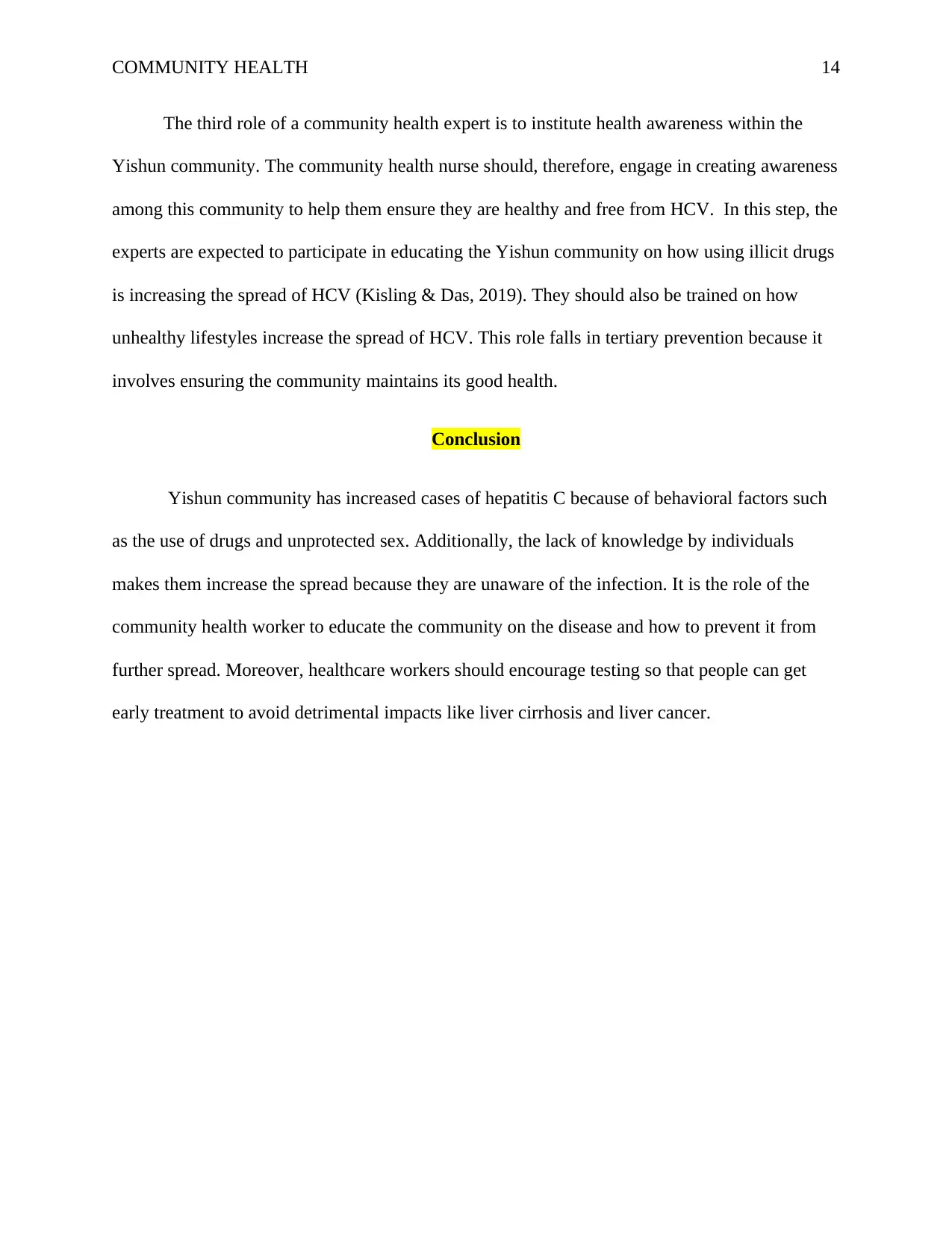
COMMUNITY HEALTH 14
The third role of a community health expert is to institute health awareness within the
Yishun community. The community health nurse should, therefore, engage in creating awareness
among this community to help them ensure they are healthy and free from HCV. In this step, the
experts are expected to participate in educating the Yishun community on how using illicit drugs
is increasing the spread of HCV (Kisling & Das, 2019). They should also be trained on how
unhealthy lifestyles increase the spread of HCV. This role falls in tertiary prevention because it
involves ensuring the community maintains its good health.
Conclusion
Yishun community has increased cases of hepatitis C because of behavioral factors such
as the use of drugs and unprotected sex. Additionally, the lack of knowledge by individuals
makes them increase the spread because they are unaware of the infection. It is the role of the
community health worker to educate the community on the disease and how to prevent it from
further spread. Moreover, healthcare workers should encourage testing so that people can get
early treatment to avoid detrimental impacts like liver cirrhosis and liver cancer.
The third role of a community health expert is to institute health awareness within the
Yishun community. The community health nurse should, therefore, engage in creating awareness
among this community to help them ensure they are healthy and free from HCV. In this step, the
experts are expected to participate in educating the Yishun community on how using illicit drugs
is increasing the spread of HCV (Kisling & Das, 2019). They should also be trained on how
unhealthy lifestyles increase the spread of HCV. This role falls in tertiary prevention because it
involves ensuring the community maintains its good health.
Conclusion
Yishun community has increased cases of hepatitis C because of behavioral factors such
as the use of drugs and unprotected sex. Additionally, the lack of knowledge by individuals
makes them increase the spread because they are unaware of the infection. It is the role of the
community health worker to educate the community on the disease and how to prevent it from
further spread. Moreover, healthcare workers should encourage testing so that people can get
early treatment to avoid detrimental impacts like liver cirrhosis and liver cancer.
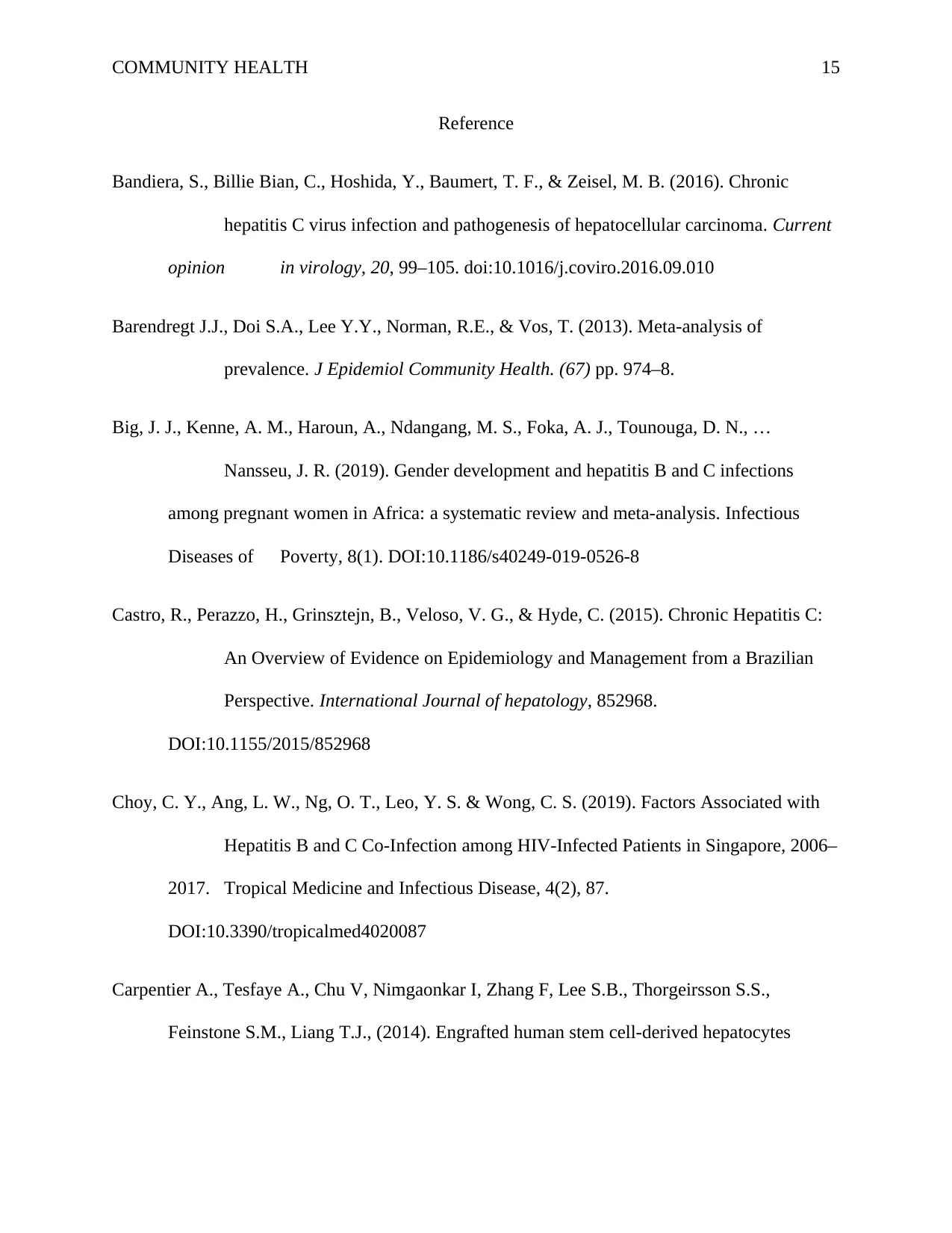
COMMUNITY HEALTH 15
Reference
Bandiera, S., Billie Bian, C., Hoshida, Y., Baumert, T. F., & Zeisel, M. B. (2016). Chronic
hepatitis C virus infection and pathogenesis of hepatocellular carcinoma. Current
opinion in virology, 20, 99–105. doi:10.1016/j.coviro.2016.09.010
Barendregt J.J., Doi S.A., Lee Y.Y., Norman, R.E., & Vos, T. (2013). Meta-analysis of
prevalence. J Epidemiol Community Health. (67) pp. 974–8.
Big, J. J., Kenne, A. M., Haroun, A., Ndangang, M. S., Foka, A. J., Tounouga, D. N., …
Nansseu, J. R. (2019). Gender development and hepatitis B and C infections
among pregnant women in Africa: a systematic review and meta-analysis. Infectious
Diseases of Poverty, 8(1). DOI:10.1186/s40249-019-0526-8
Castro, R., Perazzo, H., Grinsztejn, B., Veloso, V. G., & Hyde, C. (2015). Chronic Hepatitis C:
An Overview of Evidence on Epidemiology and Management from a Brazilian
Perspective. International Journal of hepatology, 852968.
DOI:10.1155/2015/852968
Choy, C. Y., Ang, L. W., Ng, O. T., Leo, Y. S. & Wong, C. S. (2019). Factors Associated with
Hepatitis B and C Co-Infection among HIV-Infected Patients in Singapore, 2006–
2017. Tropical Medicine and Infectious Disease, 4(2), 87.
DOI:10.3390/tropicalmed4020087
Carpentier A., Tesfaye A., Chu V, Nimgaonkar I, Zhang F, Lee S.B., Thorgeirsson S.S.,
Feinstone S.M., Liang T.J., (2014). Engrafted human stem cell-derived hepatocytes
Reference
Bandiera, S., Billie Bian, C., Hoshida, Y., Baumert, T. F., & Zeisel, M. B. (2016). Chronic
hepatitis C virus infection and pathogenesis of hepatocellular carcinoma. Current
opinion in virology, 20, 99–105. doi:10.1016/j.coviro.2016.09.010
Barendregt J.J., Doi S.A., Lee Y.Y., Norman, R.E., & Vos, T. (2013). Meta-analysis of
prevalence. J Epidemiol Community Health. (67) pp. 974–8.
Big, J. J., Kenne, A. M., Haroun, A., Ndangang, M. S., Foka, A. J., Tounouga, D. N., …
Nansseu, J. R. (2019). Gender development and hepatitis B and C infections
among pregnant women in Africa: a systematic review and meta-analysis. Infectious
Diseases of Poverty, 8(1). DOI:10.1186/s40249-019-0526-8
Castro, R., Perazzo, H., Grinsztejn, B., Veloso, V. G., & Hyde, C. (2015). Chronic Hepatitis C:
An Overview of Evidence on Epidemiology and Management from a Brazilian
Perspective. International Journal of hepatology, 852968.
DOI:10.1155/2015/852968
Choy, C. Y., Ang, L. W., Ng, O. T., Leo, Y. S. & Wong, C. S. (2019). Factors Associated with
Hepatitis B and C Co-Infection among HIV-Infected Patients in Singapore, 2006–
2017. Tropical Medicine and Infectious Disease, 4(2), 87.
DOI:10.3390/tropicalmed4020087
Carpentier A., Tesfaye A., Chu V, Nimgaonkar I, Zhang F, Lee S.B., Thorgeirsson S.S.,
Feinstone S.M., Liang T.J., (2014). Engrafted human stem cell-derived hepatocytes
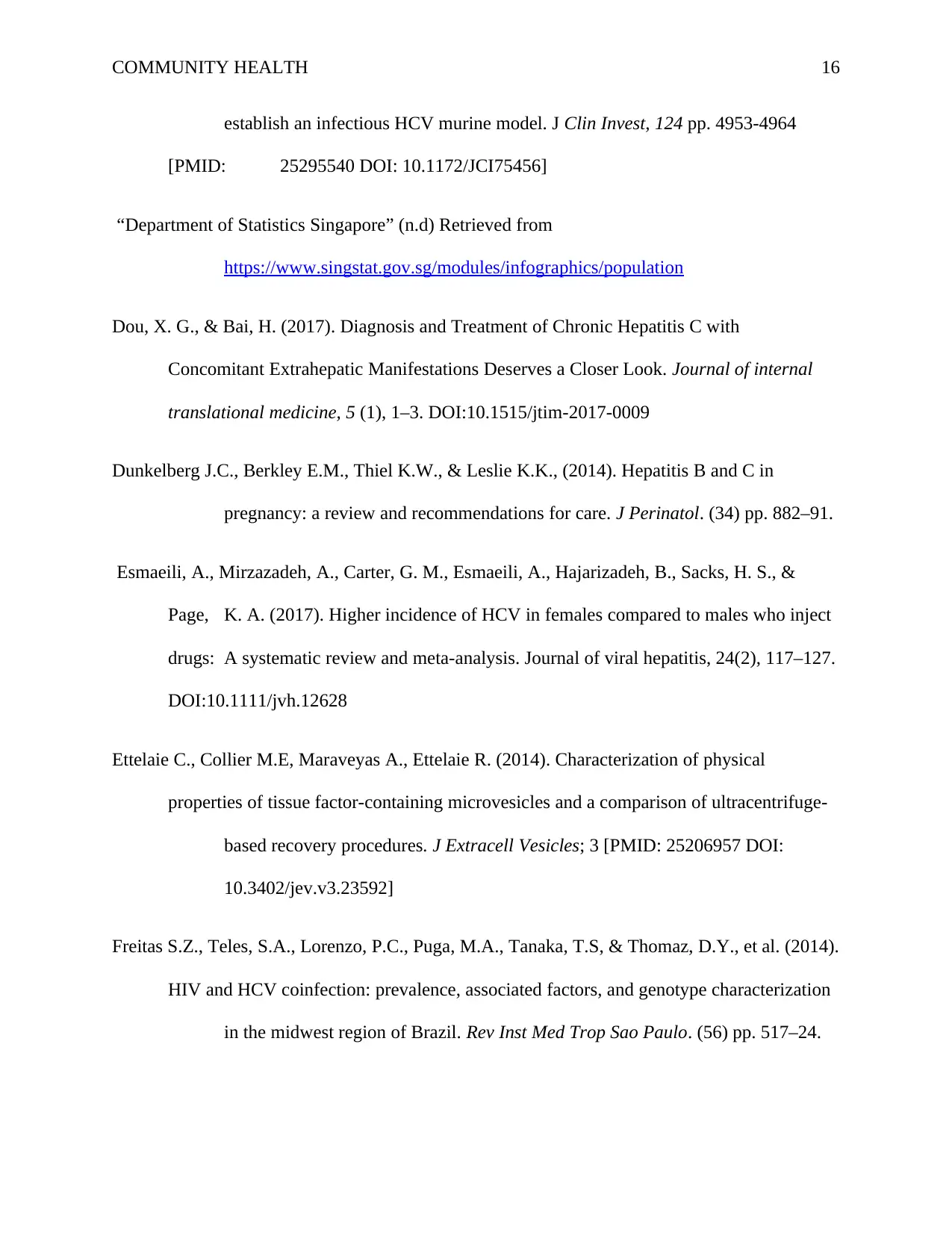
COMMUNITY HEALTH 16
establish an infectious HCV murine model. J Clin Invest, 124 pp. 4953-4964
[PMID: 25295540 DOI: 10.1172/JCI75456]
“Department of Statistics Singapore” (n.d) Retrieved from
https://www.singstat.gov.sg/modules/infographics/population
Dou, X. G., & Bai, H. (2017). Diagnosis and Treatment of Chronic Hepatitis C with
Concomitant Extrahepatic Manifestations Deserves a Closer Look. Journal of internal
translational medicine, 5 (1), 1–3. DOI:10.1515/jtim-2017-0009
Dunkelberg J.C., Berkley E.M., Thiel K.W., & Leslie K.K., (2014). Hepatitis B and C in
pregnancy: a review and recommendations for care. J Perinatol. (34) pp. 882–91.
Esmaeili, A., Mirzazadeh, A., Carter, G. M., Esmaeili, A., Hajarizadeh, B., Sacks, H. S., &
Page, K. A. (2017). Higher incidence of HCV in females compared to males who inject
drugs: A systematic review and meta-analysis. Journal of viral hepatitis, 24(2), 117–127.
DOI:10.1111/jvh.12628
Ettelaie C., Collier M.E, Maraveyas A., Ettelaie R. (2014). Characterization of physical
properties of tissue factor-containing microvesicles and a comparison of ultracentrifuge-
based recovery procedures. J Extracell Vesicles; 3 [PMID: 25206957 DOI:
10.3402/jev.v3.23592]
Freitas S.Z., Teles, S.A., Lorenzo, P.C., Puga, M.A., Tanaka, T.S, & Thomaz, D.Y., et al. (2014).
HIV and HCV coinfection: prevalence, associated factors, and genotype characterization
in the midwest region of Brazil. Rev Inst Med Trop Sao Paulo. (56) pp. 517–24.
establish an infectious HCV murine model. J Clin Invest, 124 pp. 4953-4964
[PMID: 25295540 DOI: 10.1172/JCI75456]
“Department of Statistics Singapore” (n.d) Retrieved from
https://www.singstat.gov.sg/modules/infographics/population
Dou, X. G., & Bai, H. (2017). Diagnosis and Treatment of Chronic Hepatitis C with
Concomitant Extrahepatic Manifestations Deserves a Closer Look. Journal of internal
translational medicine, 5 (1), 1–3. DOI:10.1515/jtim-2017-0009
Dunkelberg J.C., Berkley E.M., Thiel K.W., & Leslie K.K., (2014). Hepatitis B and C in
pregnancy: a review and recommendations for care. J Perinatol. (34) pp. 882–91.
Esmaeili, A., Mirzazadeh, A., Carter, G. M., Esmaeili, A., Hajarizadeh, B., Sacks, H. S., &
Page, K. A. (2017). Higher incidence of HCV in females compared to males who inject
drugs: A systematic review and meta-analysis. Journal of viral hepatitis, 24(2), 117–127.
DOI:10.1111/jvh.12628
Ettelaie C., Collier M.E, Maraveyas A., Ettelaie R. (2014). Characterization of physical
properties of tissue factor-containing microvesicles and a comparison of ultracentrifuge-
based recovery procedures. J Extracell Vesicles; 3 [PMID: 25206957 DOI:
10.3402/jev.v3.23592]
Freitas S.Z., Teles, S.A., Lorenzo, P.C., Puga, M.A., Tanaka, T.S, & Thomaz, D.Y., et al. (2014).
HIV and HCV coinfection: prevalence, associated factors, and genotype characterization
in the midwest region of Brazil. Rev Inst Med Trop Sao Paulo. (56) pp. 517–24.
Secure Best Marks with AI Grader
Need help grading? Try our AI Grader for instant feedback on your assignments.
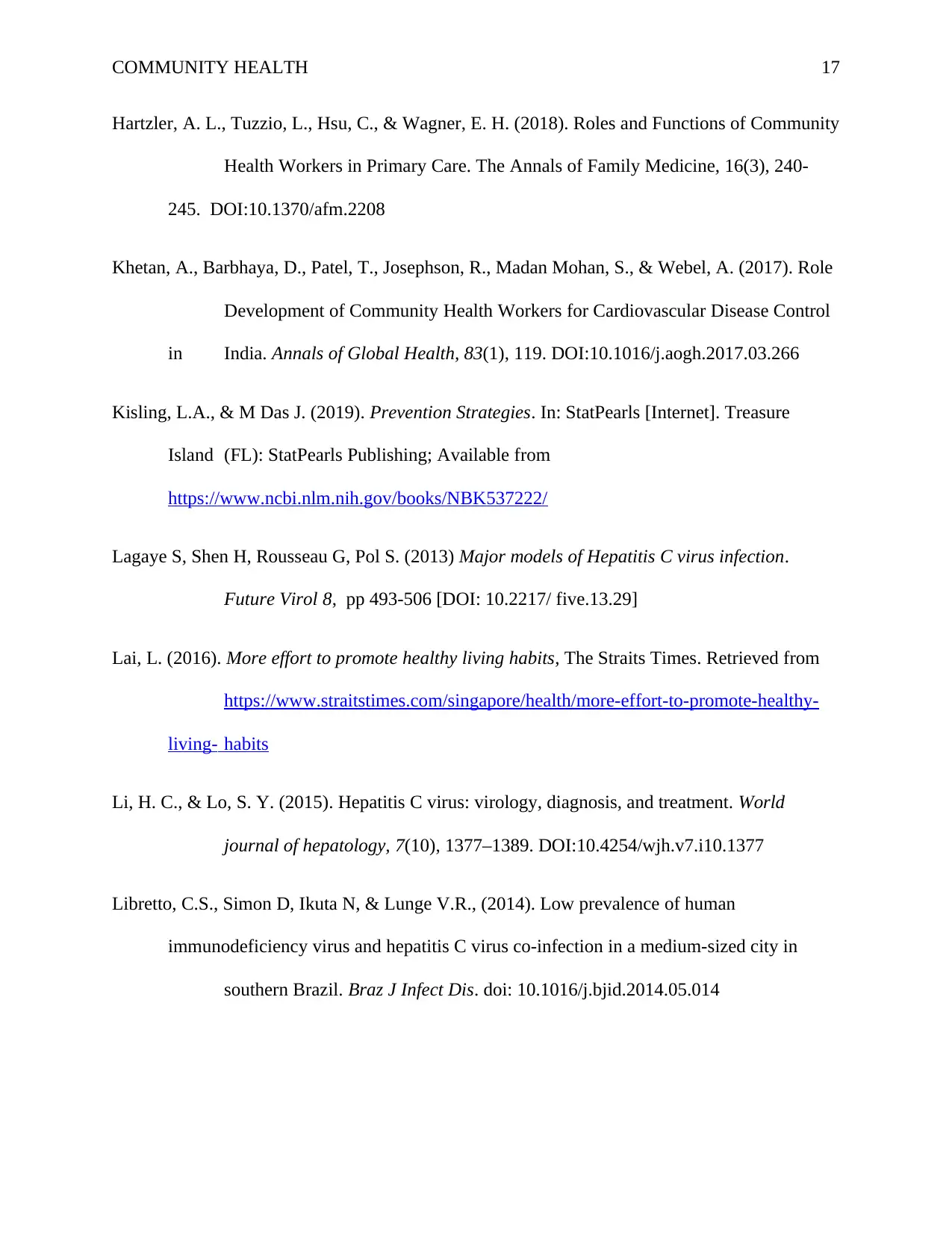
COMMUNITY HEALTH 17
Hartzler, A. L., Tuzzio, L., Hsu, C., & Wagner, E. H. (2018). Roles and Functions of Community
Health Workers in Primary Care. The Annals of Family Medicine, 16(3), 240-
245. DOI:10.1370/afm.2208
Khetan, A., Barbhaya, D., Patel, T., Josephson, R., Madan Mohan, S., & Webel, A. (2017). Role
Development of Community Health Workers for Cardiovascular Disease Control
in India. Annals of Global Health, 83(1), 119. DOI:10.1016/j.aogh.2017.03.266
Kisling, L.A., & M Das J. (2019). Prevention Strategies. In: StatPearls [Internet]. Treasure
Island (FL): StatPearls Publishing; Available from
https://www.ncbi.nlm.nih.gov/books/NBK537222/
Lagaye S, Shen H, Rousseau G, Pol S. (2013) Major models of Hepatitis C virus infection.
Future Virol 8, pp 493-506 [DOI: 10.2217/ five.13.29]
Lai, L. (2016). More effort to promote healthy living habits, The Straits Times. Retrieved from
https://www.straitstimes.com/singapore/health/more-effort-to-promote-healthy-
living- habits
Li, H. C., & Lo, S. Y. (2015). Hepatitis C virus: virology, diagnosis, and treatment. World
journal of hepatology, 7(10), 1377–1389. DOI:10.4254/wjh.v7.i10.1377
Libretto, C.S., Simon D, Ikuta N, & Lunge V.R., (2014). Low prevalence of human
immunodeficiency virus and hepatitis C virus co-infection in a medium-sized city in
southern Brazil. Braz J Infect Dis. doi: 10.1016/j.bjid.2014.05.014
Hartzler, A. L., Tuzzio, L., Hsu, C., & Wagner, E. H. (2018). Roles and Functions of Community
Health Workers in Primary Care. The Annals of Family Medicine, 16(3), 240-
245. DOI:10.1370/afm.2208
Khetan, A., Barbhaya, D., Patel, T., Josephson, R., Madan Mohan, S., & Webel, A. (2017). Role
Development of Community Health Workers for Cardiovascular Disease Control
in India. Annals of Global Health, 83(1), 119. DOI:10.1016/j.aogh.2017.03.266
Kisling, L.A., & M Das J. (2019). Prevention Strategies. In: StatPearls [Internet]. Treasure
Island (FL): StatPearls Publishing; Available from
https://www.ncbi.nlm.nih.gov/books/NBK537222/
Lagaye S, Shen H, Rousseau G, Pol S. (2013) Major models of Hepatitis C virus infection.
Future Virol 8, pp 493-506 [DOI: 10.2217/ five.13.29]
Lai, L. (2016). More effort to promote healthy living habits, The Straits Times. Retrieved from
https://www.straitstimes.com/singapore/health/more-effort-to-promote-healthy-
living- habits
Li, H. C., & Lo, S. Y. (2015). Hepatitis C virus: virology, diagnosis, and treatment. World
journal of hepatology, 7(10), 1377–1389. DOI:10.4254/wjh.v7.i10.1377
Libretto, C.S., Simon D, Ikuta N, & Lunge V.R., (2014). Low prevalence of human
immunodeficiency virus and hepatitis C virus co-infection in a medium-sized city in
southern Brazil. Braz J Infect Dis. doi: 10.1016/j.bjid.2014.05.014
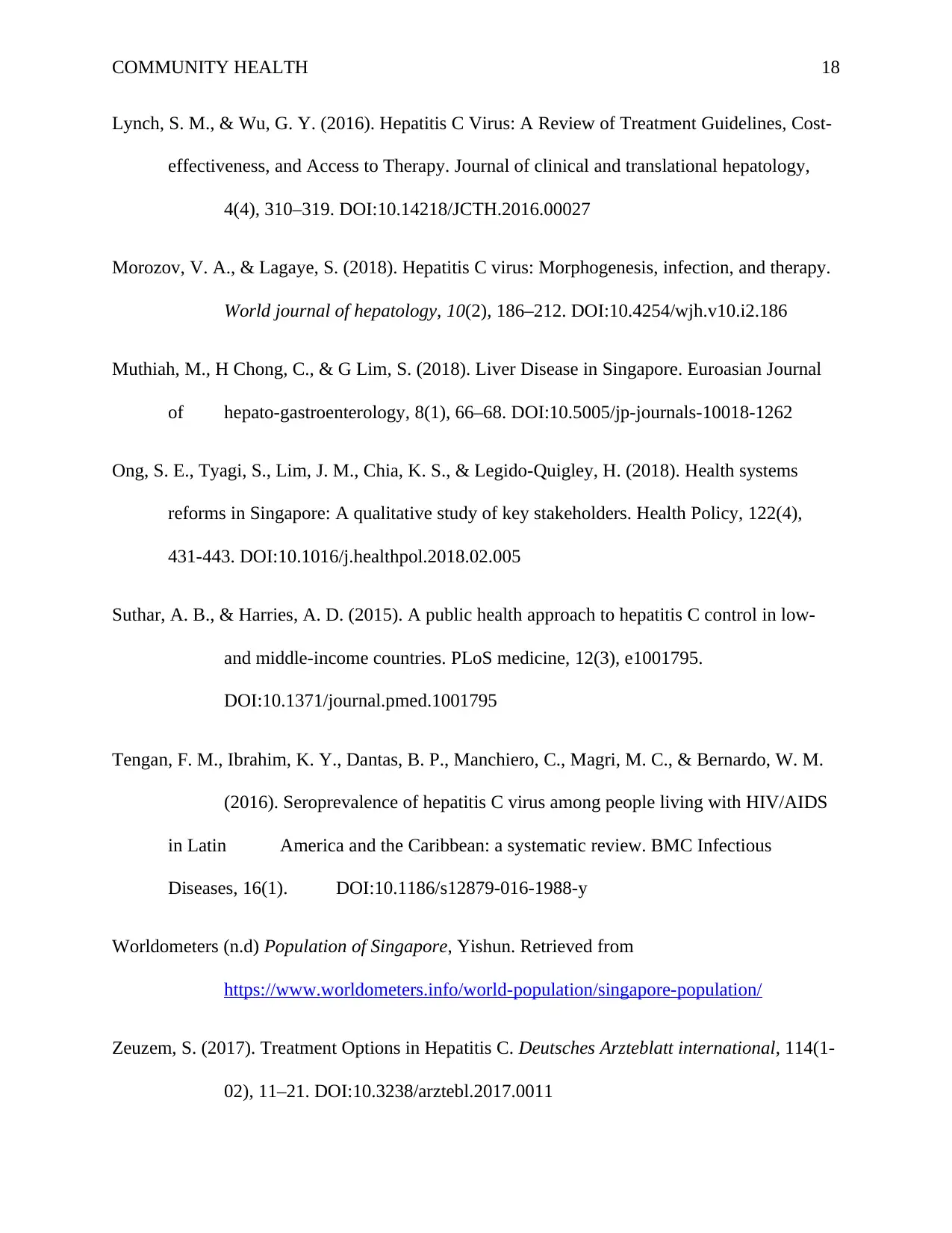
COMMUNITY HEALTH 18
Lynch, S. M., & Wu, G. Y. (2016). Hepatitis C Virus: A Review of Treatment Guidelines, Cost-
effectiveness, and Access to Therapy. Journal of clinical and translational hepatology,
4(4), 310–319. DOI:10.14218/JCTH.2016.00027
Morozov, V. A., & Lagaye, S. (2018). Hepatitis C virus: Morphogenesis, infection, and therapy.
World journal of hepatology, 10(2), 186–212. DOI:10.4254/wjh.v10.i2.186
Muthiah, M., H Chong, C., & G Lim, S. (2018). Liver Disease in Singapore. Euroasian Journal
of hepato-gastroenterology, 8(1), 66–68. DOI:10.5005/jp-journals-10018-1262
Ong, S. E., Tyagi, S., Lim, J. M., Chia, K. S., & Legido-Quigley, H. (2018). Health systems
reforms in Singapore: A qualitative study of key stakeholders. Health Policy, 122(4),
431-443. DOI:10.1016/j.healthpol.2018.02.005
Suthar, A. B., & Harries, A. D. (2015). A public health approach to hepatitis C control in low-
and middle-income countries. PLoS medicine, 12(3), e1001795.
DOI:10.1371/journal.pmed.1001795
Tengan, F. M., Ibrahim, K. Y., Dantas, B. P., Manchiero, C., Magri, M. C., & Bernardo, W. M.
(2016). Seroprevalence of hepatitis C virus among people living with HIV/AIDS
in Latin America and the Caribbean: a systematic review. BMC Infectious
Diseases, 16(1). DOI:10.1186/s12879-016-1988-y
Worldometers (n.d) Population of Singapore, Yishun. Retrieved from
https://www.worldometers.info/world-population/singapore-population/
Zeuzem, S. (2017). Treatment Options in Hepatitis C. Deutsches Arzteblatt international, 114(1-
02), 11–21. DOI:10.3238/arztebl.2017.0011
Lynch, S. M., & Wu, G. Y. (2016). Hepatitis C Virus: A Review of Treatment Guidelines, Cost-
effectiveness, and Access to Therapy. Journal of clinical and translational hepatology,
4(4), 310–319. DOI:10.14218/JCTH.2016.00027
Morozov, V. A., & Lagaye, S. (2018). Hepatitis C virus: Morphogenesis, infection, and therapy.
World journal of hepatology, 10(2), 186–212. DOI:10.4254/wjh.v10.i2.186
Muthiah, M., H Chong, C., & G Lim, S. (2018). Liver Disease in Singapore. Euroasian Journal
of hepato-gastroenterology, 8(1), 66–68. DOI:10.5005/jp-journals-10018-1262
Ong, S. E., Tyagi, S., Lim, J. M., Chia, K. S., & Legido-Quigley, H. (2018). Health systems
reforms in Singapore: A qualitative study of key stakeholders. Health Policy, 122(4),
431-443. DOI:10.1016/j.healthpol.2018.02.005
Suthar, A. B., & Harries, A. D. (2015). A public health approach to hepatitis C control in low-
and middle-income countries. PLoS medicine, 12(3), e1001795.
DOI:10.1371/journal.pmed.1001795
Tengan, F. M., Ibrahim, K. Y., Dantas, B. P., Manchiero, C., Magri, M. C., & Bernardo, W. M.
(2016). Seroprevalence of hepatitis C virus among people living with HIV/AIDS
in Latin America and the Caribbean: a systematic review. BMC Infectious
Diseases, 16(1). DOI:10.1186/s12879-016-1988-y
Worldometers (n.d) Population of Singapore, Yishun. Retrieved from
https://www.worldometers.info/world-population/singapore-population/
Zeuzem, S. (2017). Treatment Options in Hepatitis C. Deutsches Arzteblatt international, 114(1-
02), 11–21. DOI:10.3238/arztebl.2017.0011

COMMUNITY HEALTH 19
1 out of 19
Your All-in-One AI-Powered Toolkit for Academic Success.
+13062052269
info@desklib.com
Available 24*7 on WhatsApp / Email
![[object Object]](/_next/static/media/star-bottom.7253800d.svg)
Unlock your academic potential
© 2024 | Zucol Services PVT LTD | All rights reserved.


